*NURSING > STUDY GUIDE > NR 511 Test bank / NR511 Question bank (Midterm Exam and Final Exam) (Newest 2020): Differential Dia (All)
NR 511 Test bank / NR511 Question bank (Midterm Exam and Final Exam) (Newest 2020): Differential Diagnosis and Primary Care Practicum: Chamberlain | 100 % VERIFIED ANSWERS, GRADE A
Document Content and Description Below
NR 511 Test bank / NR511 Question bank (Midterm Exam and Final Exam) 1.How many sets of Kegels should be done each day to help with urinary incontinence? -Three sets of 10 a day 2. What is the first l... ine treatment for allergic rhinitis? -intranasalcorticosteroid—ie: Flonase. 3. What is the term used for the loss of high-pitched tones in geriatrics? -Presbycusis 4. What type of hearing loss does cerumen impaction cause? - Conductive hearing loss 5. You see an older woman bending over leaving on her shopping cart at the grocery store. What is the likely diagnosis? -Spinal stenosis 6. Multiple myeloma is disease of what? -Plasma cells 7. What test in the office can you use to help diagnose sciatica? - Straight leg test (Always pick the cheapest, most noninvasive tests first!!) 8. I have heel pain that is worse in the morning. What is my likely diagnosis? - Plantar fasciitis 90. The Lachman test is used to help diagnose what? - ACL 10. Other tests for acl include -anterior and posterior drawer tests 11. What is the treatment for gout and what would be the medication instructions for a flare? - Colchicine and take 1.2 mg at the first sign of flare, followed in 1 hour with a single dose of 0.6 mg. 12. What is a sign of colchicine toxicity? - Diarrhea 13. What is a common cause of posterior knee pain? -Baker’s cyst 14. Cotton wool spots, neovascularization and microaneurysms are all Eye exam findings in what condition? -Diabetes 15. And what about AV nicking and what it is? - HTN, when an artery crosses over a vein 16. What is the treatment for bacterial sinusitis? -Augmentin 17. I’m tired, have a sore throat and swollen posterior cervical nodes on exam. What is the likely diagnosis? -Mono--The best thing I can say to help differentiate those two for memory is that P in posterior is closer to M in mono in the alphabet so that’s how I remember! 18. Recall that swollen ANTERIOR cervical nodes are seen in - strep. 19. What is a common side effect of Pyridium, an anti-spasmodic for dysuria? -Orange colored urine 20. What would be included in your list of differentials for hematuria? -Bladder cancer, kidney stones, exercise induced, trauma, medications, infection, and BPH are the most common reasons 21. What is the medication treatment for MRSA? Bactrim 22. What are some symptoms a patient with lupus would complain of? - Fatigue, malar rash aka butterfly rash, and joint aches. 23.And what is the lab that you would order it to confirm it? -ANA 24. What is the term used to describe dry, itching skin? -Xerosis 25. What is the most common kind of skin cancer? - Basal cell carcinoma reminder that this cancer presents as a pearly domed nodule, pink or flesh colored and usually has telangiectasia present 26. What medication is used to treat a cat or dog bite? -Augmentin (dogmantin) 27. What do you think of when you hear a bright beefy red rash and what is the treatment? - Candidiasis and treatment is topical anti-fungal (e.g diaper rash) 28. How would you describe the prostate in BPH? - Firm, rubbery, smooth and symmetrically enlarged. NB that prostate cancer on the other hand is asymmetrical 29. A1C> what is considered T2DM? >6.5% 30. My A1C is >10, what would be the medication of choice? Insulin (also first choice medication if fasting glucose is >300!) 31. Hypothyroidism is most common in what population? - Women >50yrs 32. Your pediatric pt has bloody discharge in his ear, what’s the likely dx? - Ruptured TM 33. Your patient presents with a burn and blisters are present. What degree burn is this? -2nd degree 34 What is the treatment for pertussis? - Macrolide (Azithromycin) 35. What bug causes the greatest mortality in community acquired pneumonia? Strep pneumo 36. What would be seen on xray of a pt with TB? A black circle usually in the upper lobes 37. Most common side effect of long-term inhaled corticosteroid use? -Osteopenia and cataracts 38. S3 heart sound is a sign of what? -Congestive heart failure (keep in mind they’re normal during pregnancy) 39. What medication do use to treat a fib? - Beta blockers 40. What is pulsus paradoxus? - A decrease in systolic pressure with inspiration usually seen in asthmatics...to measure use a blood pressure cuff and stethoscope 41. The upcoming July 4th holiday reminds you of what diagnosis? -Raynauds ..red white and blue color changing of the hands. Tx? CCBs 42. Someone with high triglyceride levels is at increased risk of what? -Pancreatitis 43. Subclinical hypothyroidism is described as what lab readings? -High TSH with a normal T4 44. A positive Markle test is significant of what? -Appendicitis ...recall that the Markle test is also known as the heel jar in which the patient raises their heels then drop them suddenly and if they experience pain it’s positive for appendicitis 45. What differentials do you think of in someone with left upper quadrant pain? -Gastritis, pancreatitis, myocardial infarction, and left lower lobe pneumonia. 46. What about left lower quadrant? -Diverticulitis 47. A positive Murphy’s sign is indicative of what? -Cholecystitis. 48. What diagnostic test would you order if this were positive? - An ultrasound 49. What is the first line treatment for GERD? - H2 blockers 50. I was going to go over hepatitis B markers but I think it’s harder to say that out loud versus seeing it on paper so going to skip that but of course remember to review those for the exam too! 51. What diagnostic test should be done for suspicion of appendicitis? -CT scan ...you should also do a CT scan for diverticulitis and speaking of diverticulitis what is the treatment? Cipro and Flagyl 52. What is the confirmatory test for HIV? Per Leik 3rd edition, • Step 1: Order HIV-1/HIV-2 antibodies and P24 antigen (combination assay) with reflexes. "Reflex" means that if positive, the lab will automatically perform the follow-up test to confirm the results. 53. What is the treatment for syphilis? -Pcn G (for all stages of it) 54. And what are some presenting features of syphilis? Rashes on soles of feet and palms of hands, painless lesions (chancre) 55. Gonorrhea treatment? Rocephin (“gone-a-cephin” helps me remember this one!) 56. Cervicitis is seen in which diagnoses? -Chlamydia and gonorrhea 57. I am a healthy 63-year-old patient, what is my goal BP according to JNC 8? -<150/90 for 60yrs . Recall that less than 60yrs is <140/90 in addition to those with DM and CKD 58. What should we keep in mind when prescribing for the elderly population? -May have to start with half dose and increase slowly, side effects!! Especially anticholinergics 59. A low HDL and high trig level always means what? -Insulin insufficiency 60. The S1 is the closure of which valves? -AV valves, and S2 is closure of semilunar valves 61. On exam you feel a weakened peripheral pulse, what diagnosis do you think of? - PAD 62. An absent red reflex is indicative of what? Cataract 63. During an eye exam you note absent venous pulsations, what is this related to? -Papilledema 64. The Dix Hallpike maneuver is used to test for what condition? -Vertigo 65. What is the most well-known medication treatment for Vertigo? - Meclizine 66. What medication is prescribed for essential tremors? -BB (propranolol) 67. A young adult patient states that she is experiencing episodes of vision loss and abnormal limb sensations. What would be at the top of your list of differentials? - MS---and what would you do? REFER TO NEURO 68. When assessing a patient for dementia, what is the FIRST and best thing you should do? -GET A GOOD HX FROM PT BUT ALSO FAMILY 69. Name a difference between dementia and delirium? - Dementia is slow progress, delirium happens RAPIDLY 70. What is the MAIN cause of delirium? -Infection 71. Cranial Nerves review (just going over the MAIN ones I’ve seen in reviews/questions for the exam) --nose: 1 --vision: 2 --EOM: 3, 4, and 6 --trigeminal: 5 (trigeminal neuralgia) --facial: 7 (bell’s palsy)—HSV can cause Bell’s Palsy (keep in mind!) --ears: 8 --shoulders: 11 72. UTI treatment? - Macrobid 73. What about UTI in a pregnant pt? -Keflex or Amoxicillin 74. Anxiety…which meds to use for situational? -Benzos and GAD? SSRIs, SNRIs 75. What about OCD? SSRI, SNRI, TCA 76. Which population has the highest suicide rate? -Older, white males 77. What symptom is specific to the geriatric population when you think of UTIs? Confusion 78. PNA in Geri’s, how do they present? -We went over this last round, but felt it was important enough to repeat it. Tachypnea, extreme fatigue, and I didn’t mention last time but another thing to keep in mind with geris and PNA is that they MAY not have a fever with it because of decreased thermoregulation. Also can see delirium and falls. 79. What is the difference between sensitivity and specificity? - Sen= TRUE positive, they tested POSITIVE and HAVE the DA, whereas Spec= DON’T have the DA, tested NEG 80. What vitamin deficiency can alcohol lead to? -Thiamine deficiency (vit B1)---and INCREASED GGT levels 81. MMSE, what score indicates dementia? <24 (0-9 is severe) 82. 10mm for PPD is needed for continued investigation of TB for what two populations? -Healthcare workers and recent migrants. Note 5mm “ “-- HIV patients and immunosuppressant 83. What food is advised to try first in infants 4-6 months of age? -Rice cereal 84. What degree of curvature in scoliosis should warrant bracing? >20 degrees 85. Tanner staging, anyone need a refresher on this? 86. What is the leading cause of death in children? -ACCIDENTS 87. What sound during the Ortolani maneuver is a positive finding and signifies a possible hip abnormality (hip dysplasia) in infants. – -The "clunk" sound 88. A newborn's mother is discovered to be HBsAg (hepatitis B surface antigen) positive. Which of the following would you recommend for this infant? —Give BOTH the Hep B vaccine and immunoglobulin 89. Which method is used to diagnose gonorrheal pharyngitis or proctitis? —Thayer-Martin culture is recommended for screening to diagnose gonorrheal pharyngitis or proctitis. 90. What is the treatment for a medial tibial stress fracture (aka “shin splints”) -RICE Chapter 3. Health Promotion Multiple Choice Identify the choice that best completes the statement or answers the question. _¬¬¬¬¬¬¬¬¬¬¬¬¬¬¬¬A 1. Which of the following is a primary prevention measure for a 76-year-old man newly diagnosed with a testosterone deficiency? a. Calcium supplementation b. Testicular self-examination c. Bone density test d. Digital rectal examination __A__ 2. Which of the following is an example of secondary prevention in a 50-year-old woman? a. Yearly mammogram b. Low animal fat diet c. Use of seat belt d. Daily application of sunscreen ___B_ 3. Which of the following is an example of tertiary prevention in a patient with chronic renal failure? a. Fluid restriction b. Hemodialysis 4 days a week c. High-protein diet d. Maintenance of blood pressure at 120/80 __A__ 4. Immunizations are an example of which type of prevention? a. Primary b. Secondary c. Tertiary True/False Indicate whether the statement is true or false. __F__ 1. Prevalence is the number of new cases of a particular disease. __F__ 2. The number of cases of a particular disease for the past 5 years is an example of the incidence rate. __T__ 3. “There are 1,185,000 cases of HIV/AIDS in the United States” is an example of the morbidity rate. __T__ 4. Endemic is the term used when the presence of an event is constant. __F__ 5. The “bird” flu of 2005 to 2006 is considered a sporadic outbreak. ___T_ 6. A pandemic affects many communities in a short period of time. Chapter 3. Health Promotion Answer Section MULTIPLE CHOICE 1. ANS: A PTS: 1 2. ANS: A PTS: 1 3. ANS: B PTS: 1 4. ANS: A PTS: 1 TRUE/FALSE 1. ANS: F PTS: 1 2. ANS: F PTS: 1 3. ANS: T PTS: 1 4. ANS: T PTS: 1 5. ANS: F PTS: 1 6. ANS: T PTS: 1 Chapter 5. Evidence-Based Care Multiple Choice Identify the choice that best completes the statement or answers the question. ___D_ 1. Which of the following are parts of evidence-based practice? a. Clinician b. Patient c. Evidence d. All of the above __B__ 2. Which is the most important question to ask in nursing research? a. What findings constitute evidence? b. How will the findings be used? c. Is this a randomized controlled trial? d. What theory is being utilized? __D__ 3. Nursing research should be utilized by: a. Nurses at the bedside b. Advanced practice nurses c. Nurse researchers d. Nurses at all levels of practice __A__ 4. Applying evidence at the point of care requires: a. Readily available evidence-based resources b. Ability to review research literature c. Single articles in journals d. Current textbooks ___C_ 5. Practice guidelines are designed to: a. Be inflexible b. Be utilized in every circumstance c. Provide a reference point for decision making d. Be created by a professional organization to guide the practice of a profession ___B_ 6. Which of the following is a crucial element of developing a guideline? a. Creating a physician expert panel b. Reviewing the literature with ratings of available evidence c. Conducting an external review of a guideline d. Developing evidence-based tables ___B_ 7. Which of the following would be considered the research design for Level I evidence? a. Single, well-designed randomized clinical trial b. Systematic review of randomized clinical trial studies c. Well-designed controlled trials without randomization d. Systematic reviews of descriptive or qualitative studies ___C_ 8. Which of the following would be considered the research design for Level II evidence? a. Single descriptive or qualitative study b. Well-designed case control or cohort studies c. Single, well-designed, randomized clinical trial d. Systematic review of randomized clinical trial studies __A__ 9. Which of the following would be considered the research design for Level III evidence? a. Well-designed controlled trials without randomization b. Systematic reviews of descriptive or qualitative studies c. Systematic review of randomized clinical trial studies d. Opinion of authorities and expert committees __D__ 10. Which of the following would be considered the research design for Level IV evidence? a. Single descriptive or qualitative study b. Opinion of authorities and expert committees c. Systematic review of randomized clinical trial studies d. Well-designed controlled trials without randomization _C___ 11. Which of the following would be considered the research design for Level V evidence? a. Systematic review of randomized clinical trial studies b. Well-designed controlled trials without randomization c. Systematic reviews of descriptive or qualitative studies d. Single descriptive or qualitative study __C__ 12. Which of the following would be considered the research design for Level VI evidence? a. Systematic reviews of descriptive or qualitative studies b. Opinion of authorities and expert committees c. Well-designed case control or cohort studies d. Single descriptive or qualitative study ____B 13. Which of the following would be considered the research design for Level VII evidence? a. Well-designed controlled trials without randomization b. Opinion of authorities and expert committees c. Well-designed case control or cohort studies d. Single descriptive or qualitative study Chapter 5. Evidence-Based Care Answer Section MULTIPLE CHOICE 1. ANS: D PTS: 1 2. ANS: B PTS: 1 3. ANS: D PTS: 1 4. ANS: A PTS: 1 5. ANS: C PTS: 1 6. ANS: B PTS: 1 7. ANS: B PTS: 1 8. ANS: C PTS: 1 9. ANS: A PTS: 1 10. ANS: D PTS: 1 11. ANS: C PTS: 1 12. ANS: C PTS: 1 13. ANS: B Chapter 6. Neurological Problems Multiple Choice Identify the choice that best completes the statement or answers the question. ____D 1. Which statement about confusion is true? a. Confusion is a disease process. b. Confusion is always temporary. c. Age is a reliable predictor of confusion. d. Polypharmacy is a major contributor to confusion in older adults. ___C_ 2. Sondra’s peripheral vestibular disease causes dizziness and vertigo. Which of the following medications will help to decrease edema in the labyrinth of the ear? a. Meclizine b. Diphenhydramine c. Diamox d. Promethazine ___B_ 3. The hallmark of an absence seizure is: a. No activity at all b. A blank stare c. Urine is usually voided involuntarily d. The attack usually lasts several minutes __B__ 4. How often should drug levels be monitored when a seizure medication has controlled the seizures, and the drug level is adequate? a. Every 3 months b. Every 6 months c. Annually d. Whenever there is a problem ____C 5. Which of the following persons fits the classic description of a patient with multiple sclerosis (MS)? a. A teenage male b. A 65-year-old male c. A 25-year-old female d. A 60-year-old female ___D_ 6. Which of the following is a specific test to MS? a. Magnetic resonance imaging (MRI) b. Computed tomography (CT) scan c. A lumbar puncture d. There is no specific test. __A__ 7. Which drug for Alzheimer’s disease should be administered beginning at the time of diagnosis? a. Cholinesterase inhibitors b. Anxiolytics c. Antidepressants d. Atypical antipsychotics __A__ 8. Which hematoma occurs along the temporal cranial wall and results from tears in the middle meningeal artery? a. Epidural hematoma b. Subdural hematoma c. Subarachnoid hematoma d. Intraparenchymal hemorrhage __A__ 9. Which cranial nerve is affected in a patient with a cerebrovascular accident who has difficulty chewing? a. CN V b. CN VII c. CN IX d. CN X __D__ 10. Which statement best describes a carotid bruit? a. It is felt with the middle three fingers over the carotid artery. b. A bruit becomes audible when the lumen is narrowed to 1 mm or less. c. A low-pitched bruit is a medical emergency. d. The higher the pitch of the bruit, the higher the degree of stenosis. ___D_ 11. Which patient is more likely to have a cluster headache? a. A female in her reproductive years b. A 40-year-old African American male c. A 55-year-old female who drinks 10 cups of coffee daily d. A 45-year-old male awakened at night __D__ 12. Inattention and a sleep-wake cycle disturbance are the hallmark symptoms of? a. Dementia b. Alzheimer’s disease c. Parkinson’s disease d. Delirium ___C_ 13. Which type of meningitis is more benign, self-limiting, and caused primarily by a virus? a. Purulent meningitis b. Chronic meningitis c. Aseptic meningitis d. Herpes meningitis __A__ 14. Which is the most sensitive neuroimaging test to evaluate patients with encephalitis? a. MRI b. CT c. Electroencephalogram (EEG) d. An initial lumbar puncture ___B_ 15. What is usually the first sign or symptom that a patient would present with that would make you suspect herpes zoster? a. A stabbing pain on one small area of the body b. A vesicular skin lesion on one side of the body c. A pain that is worse upon awakening d. A lesion on the exterior ear canal ___A_ 16. Gabby, aged 22, has Bell’s palsy on the right side of her face. Her mouth is distorted, and she is concerned about permanent paralysis and pain. What do you tell her? a. “Most patients have complete recovery in 3 to 6 months.” b. “Unfortunately, you’ll probably have a small amount of residual damage.” c. “Don’t worry, I’ll take care of everything.” d. “You may have a few more episodes over the course of your lifetime but no permanent damage.” ___B_ 17. Sam, aged 65, is started on L-dopa for his Parkinson’s disease (PD). He asks why this is necessary. You tell him: a. “L-dopa is neuroprotective.” b. “The primary goal of therapy is to replace depleted stores of dopamine.” c. “This is the only drug that can provide symptomatic benefit.” d. “This is the initial monotherapy drug.” ___D_ 18. Which of the following signs is seen in a patient with more advanced PD? a. Resting tremor b. Bradykinesia c. Rigidity d. Postural instability ___B_ 19. Which of the following is the most commonly experienced symptom of migraine? a. Light sensitivity b. Pulsatile pain c. Sound sensitivity d. Experiencing an aura ___B_ 20. Which of the following characteristics differentiates peripheral vertigo from central vertigo? a. The duration of central vertigo is shorter than that of peripheral vertigo. b. There is an auditory-associated symptom with peripheral vertigo and a visual-associated symptom with central vertigo. c. Central vertigo is positional, and peripheral vertigo is not. d. The onset of central vertigo is more sudden than that of peripheral vertigo. __B__ 21. Carotid endarterectomy should be considered only for symptomatic patients with greater than what percentage of stenosis? a. Greater than 25% b. Greater than 50% c. Greater than 75% d. Only for 100% occlusion ___A_ 22. What antiplatelet agent is most widely used for secondary prevention of stroke? a. Aspirin b. Ticlopidine c. Clopidogrel d. Aspirin and clopidogrel ____D 23. Which adjunctive diagnostic test should be used in the work-up of a patient with suspected Creutzfeldt-Jakob disease or transient epileptic amnesia? a. MRI b. CT c. Cerebrospinal fluid analysis d. EEG B____ 24. Which herbal preparation may cause delirium and should be avoided in an elderly patient? a. Sam-e b. Saint John’s Wort c. Melatonin d. Saw Palmetto ___C_ 25. Which of the following activities is part of the functional activities questionnaire? a. Asking the patient to unravel a Rubik’s cube b. Determining if the patient can drive on the highway c. Asking the patient about a news event from the current week d. Seeing if the patient can keep his or her home clean _D___ 26. About 90% of all headaches are? a. Tension b. Migraine c. Cluster d. Without pathological cause _C___ 27. Which statement is true regarding driving and patients with a seizure disorder? a. Once diagnosed with a seizure disorder, patients must never drive again. b. After being seizure free for 6 months, patients may drive. c. Each state has different laws governing driving for individuals with a seizure disorder. d. These persons may drive but never alone. __B__ 28. Julie has relapsing-remitting muscular sclerosis. She has not had a good response to interferon. Which medication might help given intravenously once a month? a. Glatiramer acetate b. Natalizumab c. Fingolimod d. Glucocorticoids __A__ 29. The ‘freezing phenomenon’ is a cardinal feature of? I do not remember how the question was written a. Parkinson’s disease b. Alzheimer’s disease c. A CVA d. Bell’s palsy __C__ 30. A ratchet-like rhythmic contraction, especially in the hand, during passive stretching is known as? a. Spinothalamic dysfunction b. Ratcheting c. Cogwheeling d. Hand tremors __B__ 31. Clinical features of insidious onset, slow progression, and a lack of other findings to explain the symptoms are fairly diagnostic of which condition? a. Guillain-Barré syndrome b. Parkinson’s disease c. Alzheimer’s disease d. Huntington’s disease ___C_ 32. Which condition is characterized by the impaired ability to learn new information along with either a cognitive disturbance in language, function, or perception? a. Guillain-Barré syndrome b. Parkinson’s disease c. Alzheimer’s disease d. Delirium __D__ 33. A score of 20 to 25 on this test indicates early-stage Alzheimer’s disease: a. SLUMS b. MoCA c. FAST d. MMSE ___B_ 34. Intravenous thrombolytic therapy following an ischemic CVA should be given within how many hours of symptom onset? a. 1 hour b. 3 hours c. 6 hours d. 12 hours ___C_ 35. When administered at the beginning of an attack, oxygen therapy may help this kind of headache? a. Tension b. Migraine c. Cluster d. Stress Chapter 6. Neurological Problems Answer Section MULTIPLE CHOICE 1. ANS: D PTS: 1 2. ANS: C PTS: 1 3. ANS: B PTS: 1 4. ANS: B PTS: 1 5. ANS: C PTS: 1 6. ANS: D PTS: 1 7. ANS: A PTS: 1 8. ANS: A PTS: 1 9. ANS: A PTS: 1 10. ANS: D PTS: 1 11. ANS: D PTS: 1 12. ANS: D PTS: 1 13. ANS: C PTS: 1 14. ANS: A PTS: 1 15. ANS: B PTS: 1 16. ANS: A PTS: 1 17. ANS: B PTS: 1 18. ANS: D PTS: 1 19. ANS: B PTS: 1 20. ANS: B PTS: 1 21. ANS: B PTS: 1 22. ANS: A PTS: 1 23. ANS: D PTS: 1 24. ANS: B PTS: 1 25. ANS: C PTS: 1 26. ANS: D PTS: 1 27. ANS: C PTS: 1 28. ANS: B PTS: 1 29. ANS: A PTS: 1 30. ANS: C PTS: 1 31. ANS: B PTS: 1 32. ANS: C PTS: 1 33. ANS: D PTS: 1 34. ANS: B PTS: 1 35. ANS: C PTS: 1 Chapter 7. Skin Problems Multiple Choice Identify the choice that best completes the statement or answers the question. ___C_ 1. Simon presents with alopecia areata with well-circumscribed patches of hair loss on the crown of his head. How do you respond when he asks you the cause? a. “You must be under a lot of stress lately.” b. “It is hereditary. Did your father experience this also?” c. “The cause is unknown, but we suspect it is due to an immunologic mechanism.” d. “We’ll have to do some tests.” B____ 2. Which of the following is “a linear crack extending from the epidermis to the dermis?” a. An ulcer b. A fissure c. Lichenification d. An excoriation A____ 3. A bulla is: a. A vesicle larger than 1 cm in diameter b. An elevated solid mass with a hard texture; the shape and borders can be regular or irregular c. A superficial elevated lesion filled with purulent fluid d. Thinning of the skin (epidermis and dermis) that appears white or translucent C____ 4. An example of ecchymosis is: a. A hematoma b. A keloid c. A bruise d. A patch A____ 5. When looking under the microscope to diagnose an intravaginal infection, you see a cluster of small and oval to round shapes. What do you suspect they are? a. Spores b. Leukocytes c. Pseudohyphae d. Epithelial cells D____ 6. Your patient is in her second trimester of pregnancy and has a yeast infection. Which of the following is a treatment that you usually recommend/order in nonpregnant patients, but is listed as a Pregnancy category D? a. Vagistat vaginal cream b. Monistat combination pack c. Terazol vaginal cream d. Diflucan, 150 mg A____ 7. Tinea unguium is also known as: a. Onychomycosis b. Tinea versicolor c. Tinea manuum d. Tinea corporis D____ 8. Sally, age 25, presents with impetigo that has been diagnosed as infected with Staphylococcus. The clinical presentation is pruritic tender, red vesicles surrounded by erythema with a rash that is ulcerating. Her recent treatment has not been adequate. Which type of impetigo is this? a. Bullous impetigo b. Staphylococcal scalded skin syndrome (SSSS) c. Nonbullous impetigo d. Ecthyma B____ 9. Mark has necrotizing fasciitis of his left lower extremity. Pressure on the skin reveals crepitus due to gas production by which anaerobic bacteria? a. Staphylococcal aureus b. Clostridium perfringens c. S. pyrogenes d. Streptococcus B____ 10. When using the microscope for an intravaginal infection, you see something translucent and colorless. What do you suspect? a. A piece of hair or a thread b. Hyphae c. Leukocytes d. Spores D____ 11. Marci has a wart on her hand. She says she heard something about “silver duct tape therapy.” What do you tell her about his? a. It is an old wives’ tale. b. It is used as a last resort. c. Salicylic acid is more effective. d. It is a simple treatment that should be tried first. A____ 12. Which is the most potent and irritating dose of tretinoin? a. 0.05% liquid formulation b. 0.1% cream c. 1% foam d. 0.02% cream C____ 13. Of the following types of cellulitis, which is a streptococcal infection of the superficial layers of the skin that does not involve the subcutaneous layers? a. Necrotizing fasciitis b. Periorbital cellulitis c. Erysipelas d. “Flesh-eating” cellulitis C____ 14. Mandy presents with a cauliflower-like wart in her anogenital region. You suspect it was sexually transmitted and document this as a: a. Filiform/digitate wart b. Dysplastic cervical lesion c. Condyloma acuminata d. Koilocytosis B____ 15. Jeffrey has atopic dermatitis. You are prescribing a low-dose topical corticosteroid for him. Which would be a good choice? a. Betamethasone dipropionate 0.05% b. Hydrocortisone base 2.5% c. Halcinonide 0.1% d. Desonide 0.05% A____ 16. Harvey has a rubbery, smooth, round mass on his chest that is compressible and has a soft-to-very-firm texture. What do you diagnose this as? a. A lipoma b. A nevi c. A skin tag d. A possible adenoma C____ 17. Which of the following statements is accurate when you are removing a seborrheic keratosis lesion using liquid nitrogen? a. Do not use lidocaine as it may potentiate bleeding. b. Pinch the skin taut together. c. Use gel foam to control bleeding. d. This should be performed by a dermatologist only. D____ 18. The “B” in the ABCDEs of assessing skin cancer represents: a. Biopsy b. Best practice c. Boundary d. Border irregularity C____ 19. The majority of HSV-1 and HSV-2 infections are asymptomatic so that only which elevated antibody titer shows evidence of previous infection? a. IgA b. IgE c. IgG d. IgM D____ 20. Eighty percent of men have noticeable hair loss by what age? a. 35 b. 50 c. 70 d. 85 A____ 21. Prevalence of psoriasis is highest in which group? a. Scandinavians b. African Americans c. Asians d. Native Americans B____ 22. The most common precancerous skin lesion found in Caucasians is: a. A skin tag b. Actinic keratosis c. A melanoma d. A basal cell lesion C____ 23. Ian, age 62, presents with a wide, diffuse area of erythematous skin on his lower left leg that is warm and tender to palpation. There is some edema involved. You suspect: a. Necrotizing fasciitis b. Kaposi’s sarcoma c. Cellulitis d. A diabetic ulcer A____ 24. Josh, aged 22, has tinea versicolor. Which description is the most likely for this condition? a. There are round, hypopigmented macules on his back. b. Josh has red papules on his face. c. There are crusted plaques in Josh’s groin area. d. There are white streaks on his neck. D____ 25. Tori is on systemic antifungals for a bad tinea infection. You are aware that the antifungals may cause: a. Renal failure b. Skin discoloration c. Breathing difficulties d. Hepatotoxicity A____ 26. Which scalp problem can be caused by a fever and certain drugs? a. Telogen effluvium (TE) b. Trichotillomania c. Psoriasis d. Alopecia areata B____ 27. Why do people of African descent have a lower incidence of non-melanoma skin cancer? a. They have an increased number of melanocytes. b. Their darker skin protects from ultraviolet radiation. c. Their skin is thicker. d. Their immune system is stronger. D____ 28. Which statement is true regarding chloasma, the ‘mask of pregnancy’? a. It is caused by a decrease in the melanocyte-stimulating hormone during pregnancy. b. This condition only occurs on the face. c. Exposure to sunlight will even out the discoloration. d. It is caused by increased levels of estrogen and progesterone. C____ 29. When instructing your elderly client about treating her xerosis, what do you tell her? a. A daily hot bath may help the associated pruritus. b. Rub the skin briskly to make sure it is completely dry after bathing. c. Only take short tepid showers. d. Use a gel that is alcohol-based after bathing to soften the skin. A____ 30. Which medication used for scabies is safe for children 2 months and older? a. Permethrin cream b. Lindane c. Crotamiton lotion and cream d. Ivermectin B____ 31. Which of the following is an infraorbital fold skin manifestation in a patient with atopic dermatitis? a. Keratosis pilaris b. Dennie’s sign c. Keratoconus d. Pityriasis alba D____ 32. Which of the following statements about performing cryosurgery for actinic keratosis is true? a. It is better to slightly overfreeze the area, so you only have to do it once. b. Using liquid nitrogen, freeze each lesion for at least 30 seconds. c. Every lesion should be biopsied after using liquid nitrogen. d. The ‘freeze balls’ should be approximately one-and-a-half times as wide as they are deep. A____ 33. An example of a primary skin lesion is a/an: a. Bulla b. Scale c. Excoriation d. Fissure C____ 34. Which statement regarding necrotizing fasciitis is true? a. The hallmark of this infection is its slow and steady progression. b. Once the border of the infection is “established,” it does not spread. c. Loss of life or limb is a potential complication. d. The lesion is most dangerous, because it is painless. C____ 35. When staging a malignant melanoma using Clark’s levels, which level extends into the papillary dermis? a. Level I b. Level II c. Level III d. Level IV Chapter 7. Skin Problems Answer Section MULTIPLE CHOICE 1. ANS: C PTS: 1 2. ANS: B PTS: 1 3. ANS: A PTS: 1 4. ANS: C PTS: 1 5. ANS: A PTS: 1 6. ANS: D PTS: 1 7. ANS: A PTS: 1 8. ANS: D PTS: 1 9. ANS: B PTS: 1 10. ANS: B PTS: 1 11. ANS: D PTS: 1 12. ANS: A PTS: 1 13. ANS: C PTS: 1 14. ANS: C PTS: 1 15. ANS: B PTS: 1 16. ANS: A PTS: 1 17. ANS: C PTS: 1 18. ANS: D PTS: 1 19. ANS: C PTS: 1 20. ANS: D PTS: 1 21. ANS: A PTS: 1 22. ANS: B PTS: 1 23. ANS: C PTS: 1 24. ANS: A PTS: 1 25. ANS: D PTS: 1 26. ANS: A PTS: 1 27. ANS: B PTS: 1 28. ANS: D PTS: 1 29. ANS: C PTS: 1 30. ANS: A PTS: 1 31. ANS: B PTS: 1 32. ANS: D PTS: 1 33. ANS: A PTS: 1 34. ANS: C PTS: 1 35. ANS: C PTS: 1 Chapter 8. Eyes, Ears, Nose, and Throat Multiple Choice Identify the choice that best completes the statement or answers the question. ___B_ 1. An acutely presenting, erythematous, tender lump within the eyelid is called: a. Blepharitis b. Hordeolum c. Chalazion d. Iritis _C___ 2. The clinician is seeing a patient complaining of red eye. The clinician suspects conjunctivitis. The presence of mucopurulent discharge suggests which type of conjunctivitis? a. Viral conjunctivitis b. Keratoconjunctivitis c. Bacterial conjunctivitis d. Allergic conjunctivitis __A__ 3. Which subtype of cataracts is characterized by significant nearsightedness and a slow indolent course? a. Nuclear cataracts b. Cortical cataracts c. Posterior cataracts d. Immature cataracts _C___ 4. Which of the following statements is true concerning the use of bilberry as a complementary therapy for cataracts? a. The body converts bilberry to vitamin A, which helps to maintain a healthy lens. b. Bilberry blocks an enzyme that leads to sorbitol accumulation that contributes to cataract formation in diabetes. c. Bilberry boosts oxygen and blood delivery to the eye. d. Bilberry is a good choice for patients with diabetes as it does not interact with antidiabetic drugs. __C__ 5. A 65-year-old man presents to the clinician with complaints of increasing bilateral peripheral vision loss, poor night vision, and frequent prescription changes that started 6 months previously. Recently, he has also been seeing halos around lights. The clinician suspects chronic open-angle glaucoma. Which of the following statements is true concerning the diagnosis of chronic open-angle glaucoma? a. The presence of increased intraocular pressure measured by tonometry is definitive for the diagnosis of open-angle glaucoma. b. The clinician can definitively diagnosis open-angle glaucoma based on the subjective complaints of the patient. c. Physical diagnosis relies on gonioscopic evaluation of the angle by an ophthalmologist. d. Early diagnosis is essential in order to reverse any damage that has occurred to the optic nerve. B____ 6. Acute angle-closure glaucoma involves a sudden severe rise in intraocular pressure. Which of the following ranges represents normal intraocular pressure? a. 0 to 7 mm Hg b. 8 to 21 mm Hg c. 22 to 40 mm Hg d. 40 to 80 mm Hg A 7. As diabetic retinopathy progresses, the presence of ‘cotton wool’ spots can be detected. Cotton wool spots refer to: a. Nerve fiber layer infarctions b. Blood vessel proliferation c. Venous beading d. Retinal hemorrhage _D___ 8. Which of the following is an example of sensorineural hearing loss? a. Perforation of the tympanic membrane b. Otosclerosis c. Cholesteatoma d. Presbycusis _C___ 9. The clinician is assessing a patient complaining of hearing loss. The clinician places a tuning fork over the patient’s mastoid process, and when the sound fades away, the fork is placed without restriking it over the external auditory meatus. The patient is asked to let the clinician know when the sound fades away. This is an example of which type of test? a. Weber test b. Schwabach test c. Rinne test d. Auditory brainstem response (ABR) test _D___ 10. A patient presents to the clinician complaining of ear pain. On examination, the clinician finds that the patient has tenderness on traction of the pinna as well as when applying pressure over the tragus. These findings are classic signs of which condition? a. Otitis media b. Meniere’s disease c. Tinnitus d. Otitis externa _A___ 11. Otitis media is considered chronic when: a. Inflammation persists more than 3 months with intermittent or persistent otic discharge. b. There are more than six occurrences of otitis media in a 1-year period. c. Otitis media does not resolve after two courses of antibiotics. d. All of the above _C___ 12. The most significant precipitating event leading to otitis media with effusion is: a. Pharyngitis b. Allergies c. Viral upper respiratory infection (URI) d. Perforation of the eardrum _D___ 13. Patients with acute otitis media should be referred to a specialist in which of the following situations? a. Concurrent vertigo or ataxia b. Failed closure of a ruptured tympanic membrane c. If symptoms worsen after 3 or 4 days of treatment d. All of the above _B___ 14. Which immunoglobulin mediates the type 1 hypersensitivity reaction involved in allergic rhinitis? a. IgA b. IgE c. IgG d. IgM _A___ 15. Fluctuations and reductions in estrogen may be a contributing factor in which type of rhinitis? a. Vasomotor rhinitis b. Rhinitis medicamentosum c. Atrophic rhinitis d. Viral rhinitis _C___ 16. Sinusitis is considered chronic when there are episodes of prolonged inflammation with repeated or inadequately treated acute infection lasting greater than: a. 4 weeks b. 8 weeks c. 12 weeks d. 16 weeks __C__ 17. Which of the following antibiotics provides the best coverage in acute or chronic sinusitis when gram-negative organisms are suspected? a. Penicillin V b. Amoxicillin c. Levofloxacin d. Clindamycin _D___ 18. In which of the following situations would referral to a specialist be needed for sinusitis? a. Recurrent sinusitis b. Allergic sinusitis c. Sinusitis that is refractory to antibiotic therapy d. All of the above _A___ 19. Which type of stomatitis results in necrotic ulceration of the oral mucous membranes? a. Vincent’s stomatitis b. Allergic stomatitis c. Apthous stomatitis d. Herpetic stomatitis _B___ 20. The presence of hairy leukoplakia in a person with no other symptoms of immune suppression is strongly suggestive of which type of infection? a. HSV type 2 b. HIV c. Pneumonia d. Syphilis _D___ 21. Heart valve damage resulting from acute rheumatic fever is a long-term sequela resulting from infection with which of the following pathogens? a. Coxsackievirus b. Cytomegalovirus c. Francisellatularensis d. Group A streptococcus _B___ 22. A patient presents with the following signs and symptoms: gradual onset of low-grade fever, marked fatigue, severe sore throat, and posterior cervical lymphadenopathy. Based on the signs and symptoms alone, which of the following conditions is most likely the cause? a. Gonorrhea b. Mononucleosis c. Influenza d. Herpes zoster __C__ 23. A patient presents to the clinician with a sore throat, fever of 100.7F, and tender anterior cervical lymphadenopathy. The clinician suspects strep throat and performs a rapid strep test that is negative. What would the next step be? a. The patient should be instructed to rest and increase fluid intake as the infection is most likely viral and will resolve without antibiotic treatment. b. Because the patient does not have strep throat, the clinician should start broad spectrum antibiotics in order to cover the offending pathogen. c. A throat culture should be performed to confirm the results of the rapid strep test. d. The patient should be treated with antibiotics for strep throat as the rapid strep test is not very sensitive. _A___ 24. Which of the following medications used in the treatment of glaucoma works by constricting the pupils to open the angle and allow aqueous fluid to escape? a. Pilocarpine b. Timolol c. Brinzolamide d. Acetazolamide __D__ 25. You have a patient who is a positive for Strep on rapid antigen testing (rapid strep test). You order amoxicillin after checking for drug allergies (patient is negative) but he returns 3 days later, reporting that his temperature has gone up, not down (101.5 F in office). You also note significant adenopathy, most notably in the posterior and anterior cervical chains, some hepatomegaly, and a diffuse rash. You decide: a. to refer the patient. b. that he is having an allergic response and needs to be changed to a macrolide antibiotic. c. that his antibiotic dosage is not sufficient and should be changed. d. that he possibly has mononucleosis concurrent with his strep infection. _B___ 26. You are in the park playing with your children when you see that your friend is screaming for help. Her toddler has fallen and there is a stick lodged in his eye. The child is kicking and screaming and grabbing for the stick. You: a. instruct his mother to hold him securely and not allow him to touch the stick, then carefully remove the stick from the eye. b. stabilize the foreign object and accompany the mother and child to the local ER. c. find a water fountain, hold the child to the water, and flush the eye. d. call 911. True/False Indicate whether the statement is true or false. __F__ 1. Severe pain associated with acute otitis media signifies perforation of the tympanic membrane. Chapter 8. Eyes, Ears, Nose, and Throat Answer Section MULTIPLE CHOICE 1. ANS: B PTS: 1 2. ANS: C PTS: 1 3. ANS: A PTS: 1 4. ANS: C PTS: 1 5. ANS: C PTS: 1 6. ANS: B PTS: 1 7. ANS: A PTS: 1 8. ANS: D PTS: 1 9. ANS: C PTS: 1 10. ANS: D PTS: 1 11. ANS: A PTS: 1 12. ANS: C PTS: 1 13. ANS: D PTS: 1 14. ANS: B PTS: 1 15. ANS: A PTS: 1 16. ANS: C PTS: 1 17. ANS: C PTS: 1 18. ANS: D PTS: 1 19. ANS: A PTS: 1 20. ANS: B PTS: 1 21. ANS: D PTS: 1 22. ANS: B PTS: 1 23. ANS: C PTS: 1 24. ANS: A PTS: 1 25. ANS: D PTS: 1 26. ANS: B PTS: 1 TRUE/FALSE 1.ANS: F PTS: 1 Chapter 9. Respiratory Problems Multiple Choice Identify the choice that best completes the statement or answers the question. __A__ 1. A chronic cough lasts longer than: a. 3 weeks b. 1 month c. 6 months d. 1 year __B__ 2. You are doing a cerumen extraction and touch the external meatus of your patient’s ear. He winces and starts coughing. What is the name of this reflex? a. Baker phenomenon b. Arnold reflex c. Cough reflex d. Tragus reflex _C___ 3. Julie has a postnasal drip along with her cough. You assess her for: a. Asthma b. Sinusitis c. Allergic or vasomotor rhinitis d. Influenza __D__ 4. A patient with hypertension comes in and insists that one of his new medications is causing him to cough. When looking at his list of medications, you think the cough must be from: a. Metoprolol b. Clopidogrel c. Tadalafil d. Captopril _B___ 5. African American patients seem to have a negative reaction to which of the following asthma medications? a. Inhaled corticosteroids b. Long-term beta-agonist bronchodilators c. Leukotriene receptor agonists d. Oral corticosteroids C____ 6. Sam, age 78, presents to the clinic with respiratory symptoms. His pulmonary function tests are as follows: a normal total lung capacity, a decreased PaO2, and an increased PaCO2. On assessment, you auscultate coarse crackles and forced expiratory wheezes. What is your diagnosis? a. Asthma b. Emphysema c. Chronic bronchitis d. Influenza D____ 7. You are using the CURB-65 clinical prediction tool to decide whether Mabel, whom you have diagnosed with community-acquired pneumonia (CAP), should be hospitalized or treated at home. Her score is 3. What should you do? a. Consider home treatment. b. Plan for a short inpatient hospitalization. c. Closely supervise her outpatient treatment. d. Hospitalize and consider admitting her to the intensive care unit. __C__ 8. Why do you suspect that your patient may have a decreased response to the tuberculin skin test (TBT)? a. She is on a high-protein diet. b. She is an adolescent. c. She has been on long-term corticosteroid therapy. d. She just got over a cold. _A___ 9. Marci has been started on a tuberculosis (TB) regimen. Because isoniazid (INH) may cause peripheral neuropathy, you consider ordering which of the following drugs prophylactically? a. Pyridoxine b. Thiamine c. Probiotic d. Phytonadione __C__ 10. Jolene has breast cancer that has been staged as T1, N0, M0. What might this mean? a. The tumor size cannot be evaluated; the cancer has not spread to the lymph nodes; and the distant spread cannot be evaluated. b. The cancer is in situ; it is spreading into the lymph nodes, but the spread cannot be evaluated otherwise. c. The cancer is less than 2 cm in size and has not spread to the lymph nodes or other parts of the body. d. The cancer is about 5 cm in size; nearby lymph nodes cannot be evaluated; and there is no evidence of distant spreading. D____ 11. Nathan, a 32-year-old policeman, has a 15-pack-a-year history of smoking and continues to smoke heavily. During every visit, he gets irate when you try to talk to him about quitting. What should you do? a. Hand him literature about smoking cessation at every visit. b. Wait until he is ready to talk to you about quitting. c. Document in the record that he is not ready to quit. d. Continue to ask him at every visit if he is ready to quit. C____ 12. Your patient has decided to try to quit smoking with Chantix. You are discussing his quit date, and he will begin taking the medicine tomorrow. When should he plan to quit smoking? a. He should stop smoking today. b. He should stop smoking tomorrow. c. His quit date should be in 1 week. d. He will be ready to quit after the first 30 days. _A___ 13. Which information should be included when you are teaching your patient about the use of nicotine gum? a. The gum must be correctly chewed to a softened state and then placed in the buccal mucosa. b. Patients should not eat for 30 minutes prior to or during the use of the gum. c. Initially, one piece is chewed every 30 minutes while awake. d. Acidic foods and beverages should be encouraged during nicotine therapy. D____ 14. Your patient states he has a strep throat infection. Which of the following symptoms makes you consider a viral etiology instead? a. Fever b. Headache c. Exudative pharyngitis d. Rhinorrhea _A___ 15. What is the first-line recommended treatment against Group A -hemolytic streptococci (GABHS), the most common cause of bacterial pharyngitis? a. Penicillin b. Quinolone c. Cephalosporin d. Macrolide C____ 16. Cydney presents with a history of asthma. She has not been treated for a while. She complains of daily but not continual symptoms, greater than 1 week and at nighttime. She has been using her rescue inhaler. Her FEV1 is 60% to 80% predicted. How would you classify her asthma severity? a. Mild intermittent b. Mild persistent c. Moderate persistent d. Severe persistent A____ 17. Joyce is taking a long-acting beta agonist for her asthma. What additional medication should she be taking? a. Inhaled corticosteroid b. Leukotriene receptor antagonist c. Systemic corticosteroid d. Methyl xanthenes _C___ 18. Your patient is on Therabid for his asthma. You want to maintain his serum levels between: a. 0 to 5 mcg/mL b. 5 to 10 mcg/mL c. 5 to 15 mcg/mL d. 10 to 20 mcg/mL _A___ 19. George has chronic obstructive pulmonary disease (COPD) and an 80% forced expiratory volume in 1 second. How would you classify the severity of his COPD? a. Stage 1 mild COPD b. Stage 2 moderate COPD c. Stage 3 severe COPD d. Stage 5 very severe COPD _C___ 20. Most nosocomial pneumonias are caused by: a. Fungi b. Viruses c. Gram-negative bacteria d. Pneumococcal pneumonia B____ 21. Which of the following statements regarding TST is true? a. Tests should be read 48 hours after the injection. b. The size of the TST reaction has nothing to do with erythema but is based solely on induration. c. It is a type V T cell-mediated immune response. d. The diameter of the induration is measured in centimeters. A____ 22. Which obstructive lung disease is classified as reversible? a. Asthma b. Chronic bronchitis c. Emphysema d. COPD B____ 23. You have taught Jennifer, age 15, about using a flow meter to assess how to manage her asthma exacerbations. She calls you today because her peak expiratory flow rate is 65%. What would you tell her? a. “Take your short-acting beta-2 agonist, remain quiet, and call back tomorrow.” b. “Use your rescue inhaler, begin the prescription of oral glucocorticoids you have, and call back tomorrow.” c. “Drive to the emergency room now.” d. “Call 911.” B____ 24. Which statement about adenocarcinoma of the lung is accurate? a. It is the least common type of lung cancer, representing approximately 5% to 10% of cases. b. It is the most prevalent carcinoma of the lungs in both sexes and in nonsmokers, representing 35% to 40% of all tumors. c. It is more common in men than in women and occurs almost entirely in cigarette smokers. d. It is aggressive, with rapid growth and early local and distant metastases via the lymphatic and blood vessels. _B___ 25. Jason, age 62, has obstructive sleep apnea. What do you think is one of his contributing factors? a. He is a recovering alcoholic of 6 years. b. His collar size is 17 inches. It will come as 19 inches c. He is the only person in his family who has this. d. He is extremely thin. _D___ 26. The forced vital capacity is decreased in: a. Asthma b. Chronic bronchitis c. Emphysema d. Restrictive disease A____ 27. The most common cause of CAP is? a. Streptococcus pneumoniae b. Klebsiella pneumoniae c. Legionella pneumoniae d. Pseudomonas aeruginosa B____ 28. Which of the following patients would you expect to have a decreased response to TST? a. Julie, a 50-year-old postal worker b. Sandy, a 40-year-old patient who recently survived a fire that left 40% of her total body surface covered in burns c. Jill, a 16-year-old cheerleader d. Mark, a 29-year-old tennis player C____ 29. Which of the following is a possible consequence of sleep apnea? a. Asthma b. Increased white blood cells c. Insulin resistance d. Hyperactivity C____ 30. Which of the following conditions is associated with cigarette smoking? a. Glaucoma b. Increased sperm quality c. Bladder cancer d. Eczema A____ 31. Marta is taking TB drugs prophylactically. How do you instruct her to take them? a. Take them on an empty stomach to facilitate absorption. b. Take them with aspirin (ASA) to prevent flushing. c. Take them with ibuprofen to prevent a headache. d. Take them with food to prevent nausea. _D___ 32. Which of the following statements regarding pulmonary function is true? a. Cigarette smoking accelerates the decline in pulmonary function tenfold. b. Smoking cessation can reverse most pathological changes. c. Cigarette smoking decreases mucus production. d. There is a normal age-related decline in pulmonary function. B____ 33. The barrel chest characteristic of emphysema is a result of: a. Chronic coughing b. Hyperinflation c. Polycythemia d. Pulmonary hypertension __D__ 34. Supplemental oxygen for how many hours per day has been shown to improve the mortality associated with COPD? a. 3 to 5 hours b. 6 to 10 hours c. 11 to 14 hours d. 15 to 18 hours _A___ 35. Which ethnic group has the highest lung cancer incidence and mortality rates? a. African American men b. Scandinavian men and women c. Caucasian women d. Asian men Chapter 9. Respiratory Problems Answer Section MULTIPLE CHOICE 1. ANS: A PTS: 1 2. ANS: B PTS: 1 3. ANS: C PTS: 1 4. ANS: D PTS: 1 5. ANS: B PTS: 1 6. ANS: C PTS: 1 7. ANS: D PTS: 1 8. ANS: C PTS: 1 9. ANS: A PTS: 1 10. ANS: C PTS: 1 11. ANS: D PTS: 1 12. ANS: C PTS: 1 13. ANS: A PTS: 1 14. ANS: D PTS: 1 15. ANS: A PTS: 1 16. ANS: C PTS: 1 17. ANS: A PTS: 1 18. ANS: C PTS: 1 19. ANS: A PTS: 1 20. ANS: C PTS: 1 21. ANS: B PTS: 1 22. ANS: A PTS: 1 23. ANS: B PTS: 1 24. ANS: B PTS: 1 25. ANS: B PTS: 1 26. ANS: D PTS: 1 27. ANS: A PTS: 1 28. ANS: B PTS: 1 29. ANS: C PTS: 1 30. ANS: C PTS: 1 31. ANS: A PTS: 1 32. ANS: D PTS: 1 33. ANS: B PTS: 1 34. ANS: D PTS: 1 35. ANS: A PTS: 1 Chapter 10. Cardiovascular Problems Multiple Choice Identify the choice that best completes the statement or answers the question. __B__ 1. Which group would most benefit from statins? a. Those with a low density lipoprotein-cholesterol greater than 100 mg/dL b. Individuals with clinical arteriosclerotic cardiovascular disease c. Individuals with a 10-year risk greater than 10% d. Individuals of all ages with diabetes mellitus (DM) _C___ 2. If chest pain can be alleviated with time, analgesics, and heat applications, what might the differential diagnosis be? a. Peptic ulcer b. Hiatal hernia c. Costochondritis d. Pericarditis _A___ 3. Sandra has palpitations that occur with muscle twitching, paresthesia, and fatigue. What specific diagnostic test might help determine the cause? a. Serum calcium b. Electrocardiogram (ECG) c. Thyroid-stimulating hormone test d. Complete blood cell count __C__ 4. A blood pressure (BP) of 150/90 is considered: a. Stage 2 hypertension b. Hypertensive c. Normal in healthy older adults d. Acceptable if the patient has DM __D__ 5. Lifestyle modifications to manage hypertension (HTN) include: a. Maintaining a body mass index of 17 b. Restricting dietary sodium to 2 grams per day c. Engaging in exercise or physical activity for 90 minutes a day d. Limiting beer intake to 24 ounces per day _A___ 6. Mary has hypertension and previously had a stroke. Which hypertensive drug would you order for her? a. Angiotensin converting enzyme inhibitor b. Calcium channel blocker c. Angiotensin II receptor blocker d. Beta blocker __D__ 7. Which high-density lipoprotein (HDL) level is considered cardioprotective? a. Greater than 30 b. Greater than 40 c. Greater than 50 d. Greater than 60 A____ 8. You are assessing Sigred for metabolic syndrome. Which of her parameters is indicative of this syndrome? a. Her waist is 36 inches. b. Her triglyceride level is 140 mg/dL. c. Her BP is 128/84. d. Her fasting blood sugar (BS) is 108 mg/dL. _C___ 9. Which type of angina do you suspect in Harvey, who complains of chest pain that occurs during sleep and most often in the early morning hours? a. Stable angina b. Unstable angina c. Variant (Prinzmetal’s angina) d. Probably not angina but hiatal hernia _A___ 10. Which ECG change is typical of cardiac ischemia? a. T-wave inversion b. ST-segment elevation c. Significant Q wave d. U-wave B____ 11. In which type of arterioventricular (AV) block does the pulse rate (PR) interval lengthen until a beat is dropped? a. First-degree AV block b. Second-degree Mobitz I AV block c. Second-degree Mobitz II AV block d. Third-degree AV block __C__ 12. A Delta wave on the ECG may be present in which condition? a. Prinzmetal’s angina b. Bundle branch block c. Wolff-Parkinson-White syndrome d. Aortic stenosis __D__ 13. Which heart sound may be heard with poorly controlled hypertension, angina, and ischemic heart disease? a. A physiologic split S2 b. A fixed split S2 c. S3 d. S4 _D___ 14. Samuel is going to the dentist for some work and must take endocarditis prophylaxis because of his history of: a. Severe asthma b. A common valvular lesion c. Severe hypertension d. A prosthetic heart valve B____ 15. George, age 64, has cardiovascular disease (CVD), a total cholesterol of 280 mg/dL, and a systolic BP of 158. He is being treated for hypertension. You are doing a Framingham Risk Assessment on him. Which assessment factor would give him the highest number of points on the scale? a. His age b. His cholesterol level c. His systolic BP d. The fact that he is on antihypertensive medication _C___ 16. Which pain characteristic is usually indicative of cardiac pathology? a. Fleeting b. Moving c. Diffuse d. Localized B____ 17. What percentage of patients with angina pectoris will have simultaneous dyspnea, caused by transient increase in pulmonary venous pressures that accompany ventricular stiffening during an episode of myocardial ischemia? a. About 20% b. About 30% c. About 50% d. Almost all _A___ 18. Nitroglycerine (NTG) is given for a patient having ischemic chest pain. One tablet or one spray should be used under the tongue every 5 minutes for three doses. What should be done if the pain has not been relieved after three doses? a. 911 should be called, and the patient should be transported immediately to the emergency department. b. One more dose of NTG may be tried. c. The person should be given two aspirin to chew. d. A portable defibrillator should be located to ascertain the cardiac rhythm. D____ 19. For the best therapeutic effect after a myocardial infarction (MI), thrombolytics should be administered within the first 3 hours (ideally 30 minutes) of symptom onset. Studies have shown, however, that thrombolytic therapy can be of benefit up to how many hours after the initial presentation of MI symptoms? a. 6 hours b. 8 hours c. 10 hours d. 12 hours _C___ 20. When teaching post MI patients about their NTG tablets, the clinician should stress that the tablets should remain in the light-resistant bottle in which they are packaged and should not be put in another pill box or remain in areas that are or could become warm and humid. Once opened, the bottle must be dated and discarded after how many months? a. 1 month b. 3 months c. 6 months d. As long as the tablets are kept in this special bottle, they will last forever. _D___ 21. There are four stages of heart failure, classified as A to D, that describe the evolution and progression of disease. In which stage are patients hospitalized or treated with specialized interventions or hospice care for refractory symptoms of heart failure despite medical therapy? a. Stage A b. Stage B c. Stage C d. Stage D _A___ 22. Which of the following is abundant in the heart and rapidly rises in the bloodstream in the presence of heart failure, making it a good diagnostic test? a. B-type natriuretic peptide b. C-reactive protein c. Serum albumin d. Erythrocyte sedimentation rate _C___ 23. Which test has long been considered the gold standard for a diagnosis of venous thromboembolism? a. Ultrasound b. Magnetic resonance imaging (MRI) c. Ascending venogram d. D-dimer __C__ 24. Statins are approved for which age group? a. Children over the age of 2 b. Children over the age of 6 c. Children over the age of 10 d. Only adolescents and adults _D___ 25. The American College of Cardiology/American Heart Association states which of the following regarding the use of non-statin lipid-lowering agents? a. Nicotinic acid derivatives are effective for lowering LDL and triglycerides (TGs). b. Bile acid sequestrates increase HDL. c. Cholesterol absorption inhibitors decrease LDL. d. There is no sufficient evidence to use non-statin lipid-drugs. A____ 26. Which of the following medications can cause hyperlipidemia? a. Diuretics b. NSAIDs c. Opioids d. Insulin D____ 27. Jamie, age 55, has just started on a statin after having his liver function tests (LFTs) come back normal. He now asks you how often he has to have the LFTs repeated. What do you tell him? a. Initially in 6 weeks b. Every 3 months c. Every 6 months d. It’s no longer necessary for his statin regimen. _C___ 28. In the CHADS2 Index for the stroke risk score for AF, the ‘A’ stands for: a. Anticoagulation b. Autoimmune disease c. Age d. Antihypertension _A___ 29. Which murmurs are usually ‘watch and wait’? a. Systolic murmurs b. Diastolic murmurs c. They both are dangerous and need immediate attention. d. You can ‘watch and wait’ for both of them. B____ 30. Which of the following statements about dabigatran is true? a. It is difficult to keep the patient in therapeutic range. b. Anticoagulation cannot be immediately reversed. c. It allows for the use of tPA if the patient has a stroke despite anticoagulation. d. None of the statements are true. C____ 31. What value on the ankle-brachial index diagnoses peripheral artery disease? a. Less than 0.25 b. Less than 0.50 c. Less than 0.90 d. Greater than 1 __D__ 32. Your patient with permanent afib asks when he can discontinue his warfarin. You tell him: a. When your internalized normalized ratio reaches 3.0, you can stop taking your warfarin permanently. b. When you no longer feel ill c. One month after your symptoms dissipate d. You’ll probably be on it indefinitely. _A___ 33. You just started Martha on HTN therapy. The Eighth Joint National Committee recommends that if her goal BP is not reached in what length of time, you should increase the initial drug or add a second drug to it? a. 1 month b. 3 months c. 6 months d. 1 year Chapter 10. Cardiovascular Problems Answer Section MULTIPLE CHOICE 1. ANS: B PTS: 1 2. ANS: C PTS: 1 3. ANS: A PTS: 1 4. ANS: C PTS: 1 5. ANS: D PTS: 1 6. ANS: A PTS: 1 7. ANS: D PTS: 1 8. ANS: A PTS: 1 9. ANS: C PTS: 1 10. ANS: A PTS: 1 11. ANS: B PTS: 1 12. ANS: C PTS: 1 13. ANS: D PTS: 1 14. ANS: D PTS: 1 15. ANS: B PTS: 1 16. ANS: C PTS: 1 17. ANS: B PTS: 1 18. ANS: A PTS: 1 19. ANS: D PTS: 1 20. ANS: C PTS: 1 21. ANS: D PTS: 1 22. ANS: A PTS: 1 23. ANS: C PTS: 1 24. ANS: C PTS: 1 25. ANS: D PTS: 1 26. ANS: A PTS: 1 27. ANS: D PTS: 1 28. ANS: C PTS: 1 29. ANS: A PTS: 1 30. ANS: B PTS: 1 31. ANS: C PTS: 1 32. ANS: D PTS: 1 33. ANS: A PTS: 1 Chapter 11. Abdominal Problems Multiple Choice Identify the choice that best completes the statement or answers the question. __D__ 1. A 35-year-old female patient is seen in the clinic complaining of abdominal pain. Which of the following should be included in the history and physical examination? a. Digital rectal exam b. Pelvic exam c. Sexual history d. All of the above __C__ 2. A patient comes to the office complaining of constipation. The patient lists all of the following medications. Which drug could be responsible for the constipation? a. Multivitamin b. Magnesium hydroxide c. Pepto-Bismol® d. Ibuprofen _D___ 3. A patient is seen with complaints of diarrhea. Which of the following should be included in the patient’s differential diagnosis? a. Gastroenteritis b. Inflammatory bowel disease c. Lactase deficiency d. All of the above _C___ 4. Mr. J. K., 38 years old, is 5 feet 8 inches tall and weighs 189 pounds. He reports that he has had intermittent heartburn for several months and takes Tums® with temporary relief. He has been waking during the night with a burning sensation in his chest. Which additional information would lead you to believe that gastroesophageal reflux disease (GERD) is the cause of his pain? a. The pain seems better when he smokes to relieve his nerves. b. Coffee and fried foods don’t bother him, c. He wakes at night coughing with a bad taste in his mouth. d. All of the above _C___ 5. A 29-year-old Englishman is seen in the office with complaints of pain in his chest and belly. He has been suffering the pain for 2 weeks and gets temporary relief from Alka-Seltzer®. The burning pain wakes him at night and radiates up to his chest. Which factor favors a diagnosis of gastric ulcer? a. His gender b. His age c. His use of Alka-Seltzer d. His ethnic origin _A___ 6. Which of the following is most effective in diagnosing appendicitis? a. History and physical b. Sedimentation rate c. Kidney, ureter, and bladder x-ray d. Complete blood count (CBC) with differentials __A__ 7. Which of the following is associated with celiac disease (celiac sprue)? a. Malabsorption b. Constipation c. Rectal bleeding d. Esophageal ulceration _D___ 8. A 45-year-old patient presents with a chief complaint of generalized abdominal pain. Her physical examination is remarkable for left lower quadrant tenderness. At this time, which of the following should be considered in the differential diagnosis? a. Endometriosis b. Colon cancer c. Diverticulitis d. All of the above __B__ 9. A 46-year-old patient is seen in the clinic with abdominal pain. Which of the following tests is essential for this patient? a. CBC with differential b. Urine human chorionic gonadotropin c. Barium enema d. Computed tomography of the abdomen _A___ 10. A 25-year-old accountant is seen in the clinic complaining of crampy abdominal pain after meals. She is often constipated and takes laxati [Show More]
Last updated: 1 year ago
Preview 1 out of 110 pages
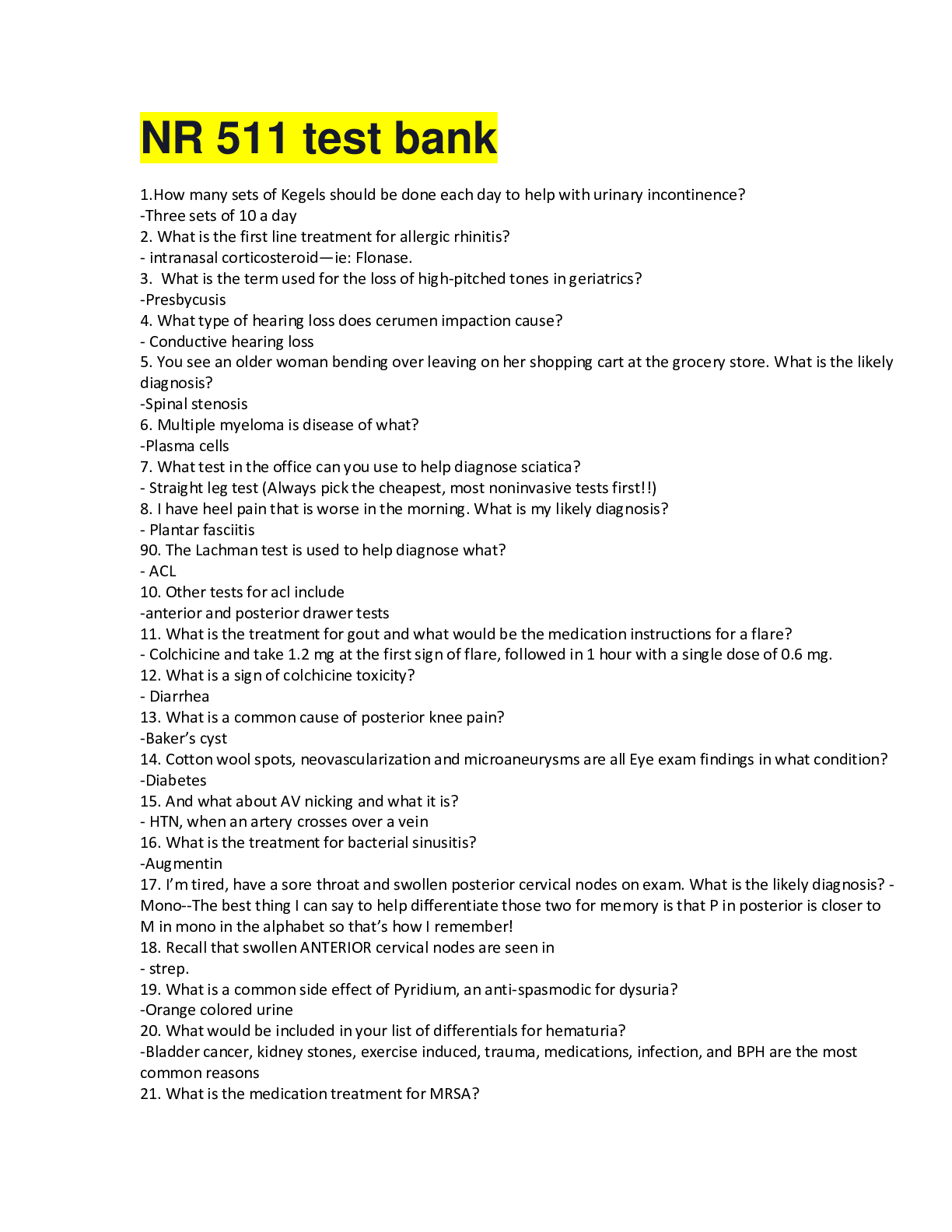
Reviews( 0 )
Document information
Connected school, study & course
About the document
Uploaded On
Jul 31, 2020
Number of pages
110
Written in
Additional information
This document has been written for:
Uploaded
Jul 31, 2020
Downloads
0
Views
54

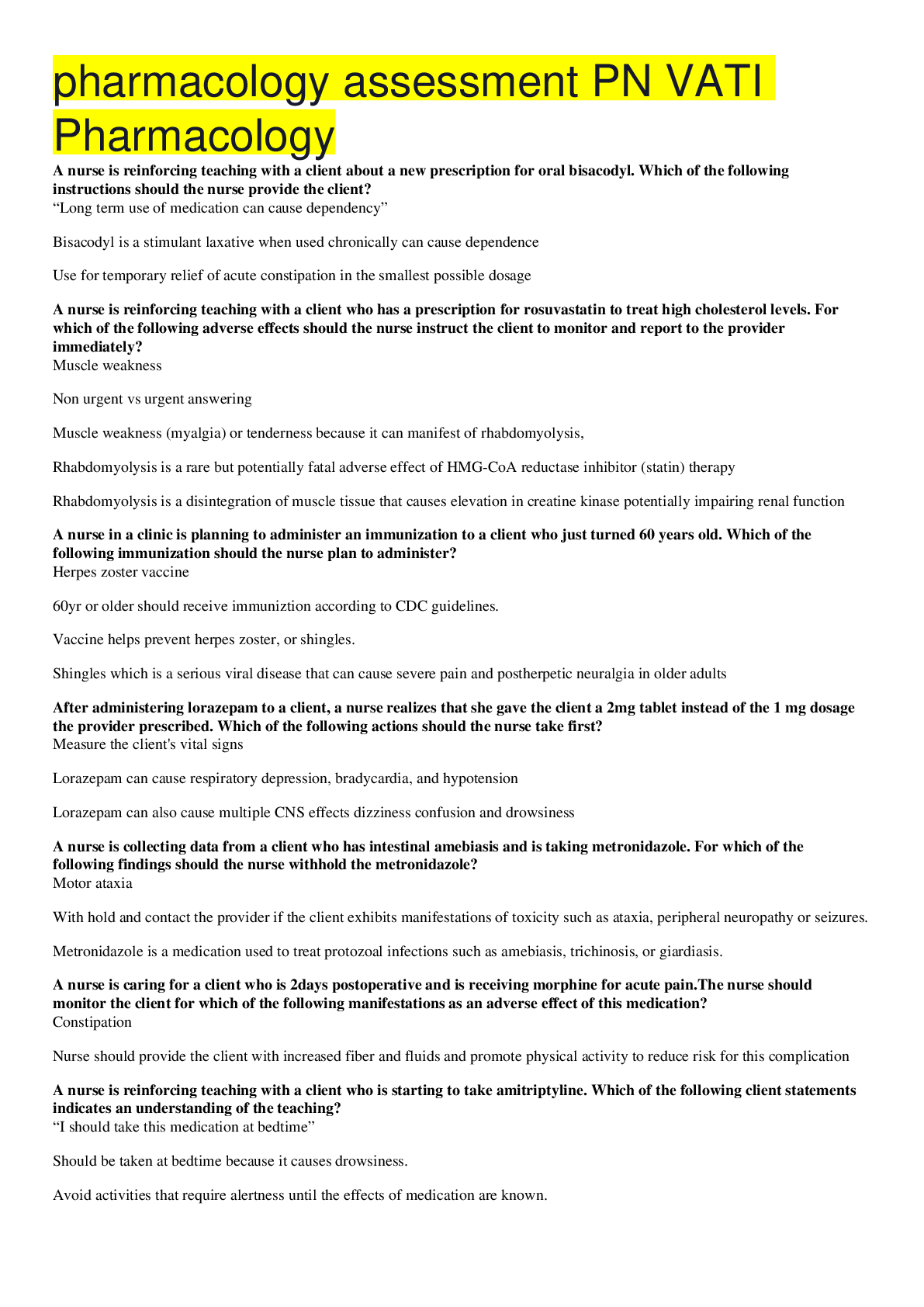
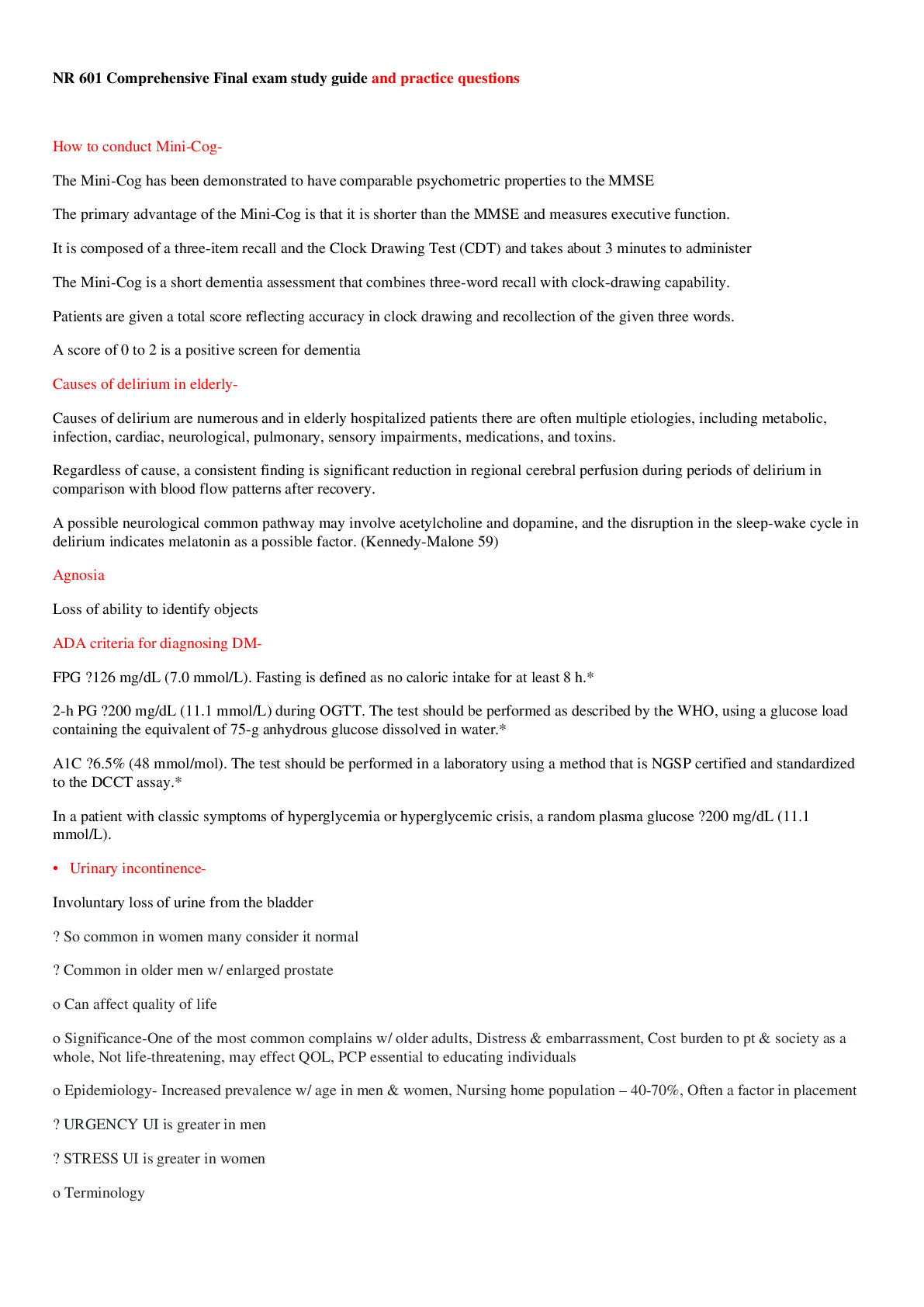
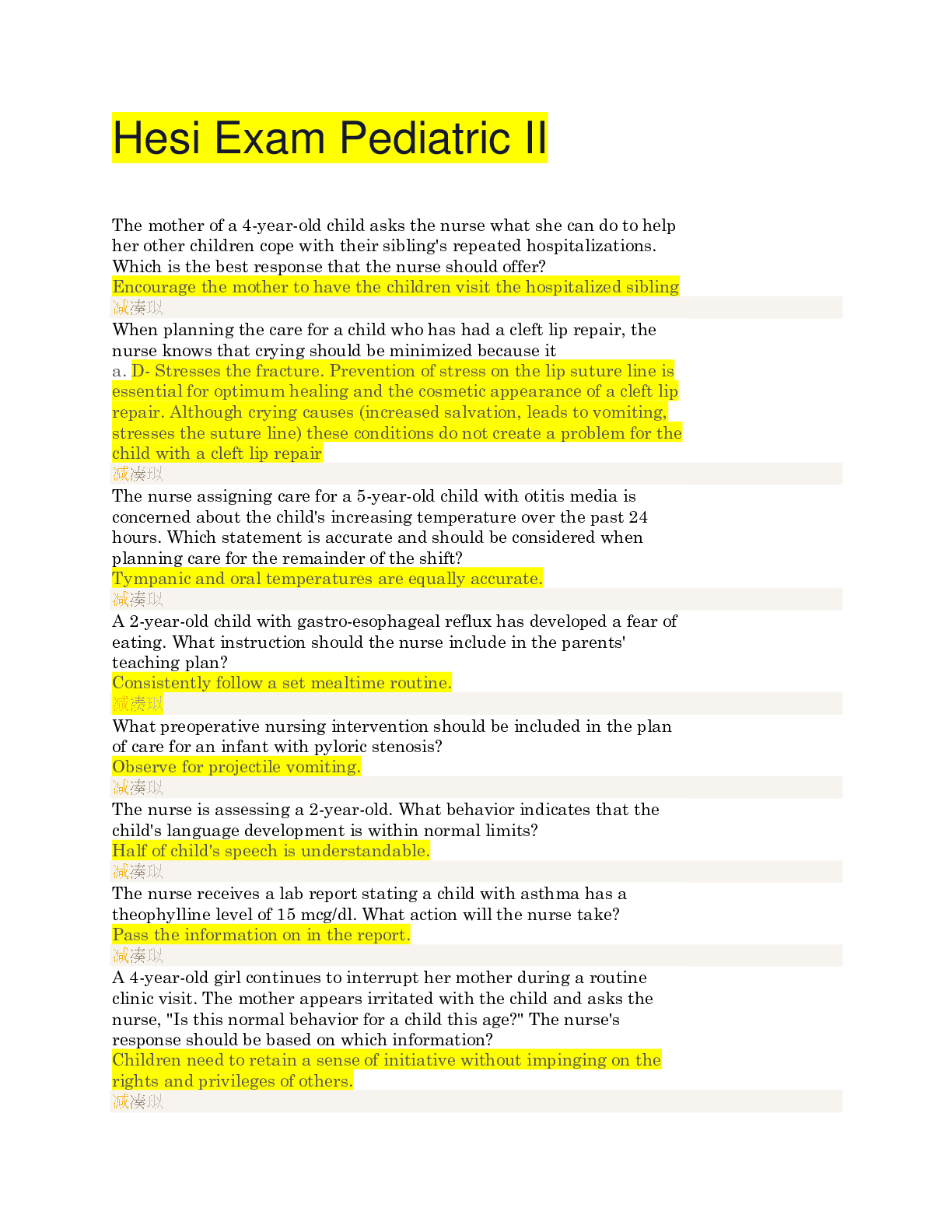


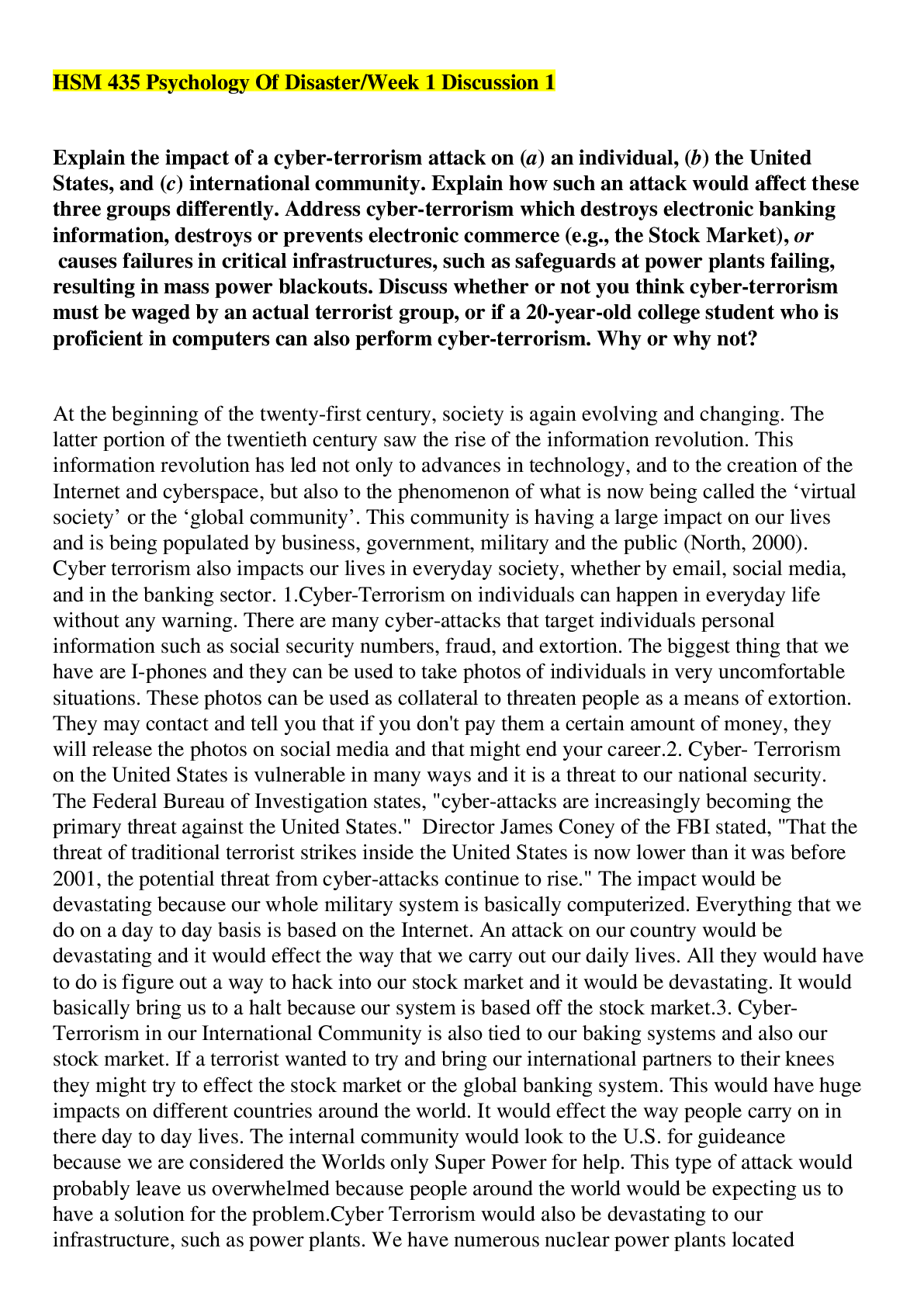

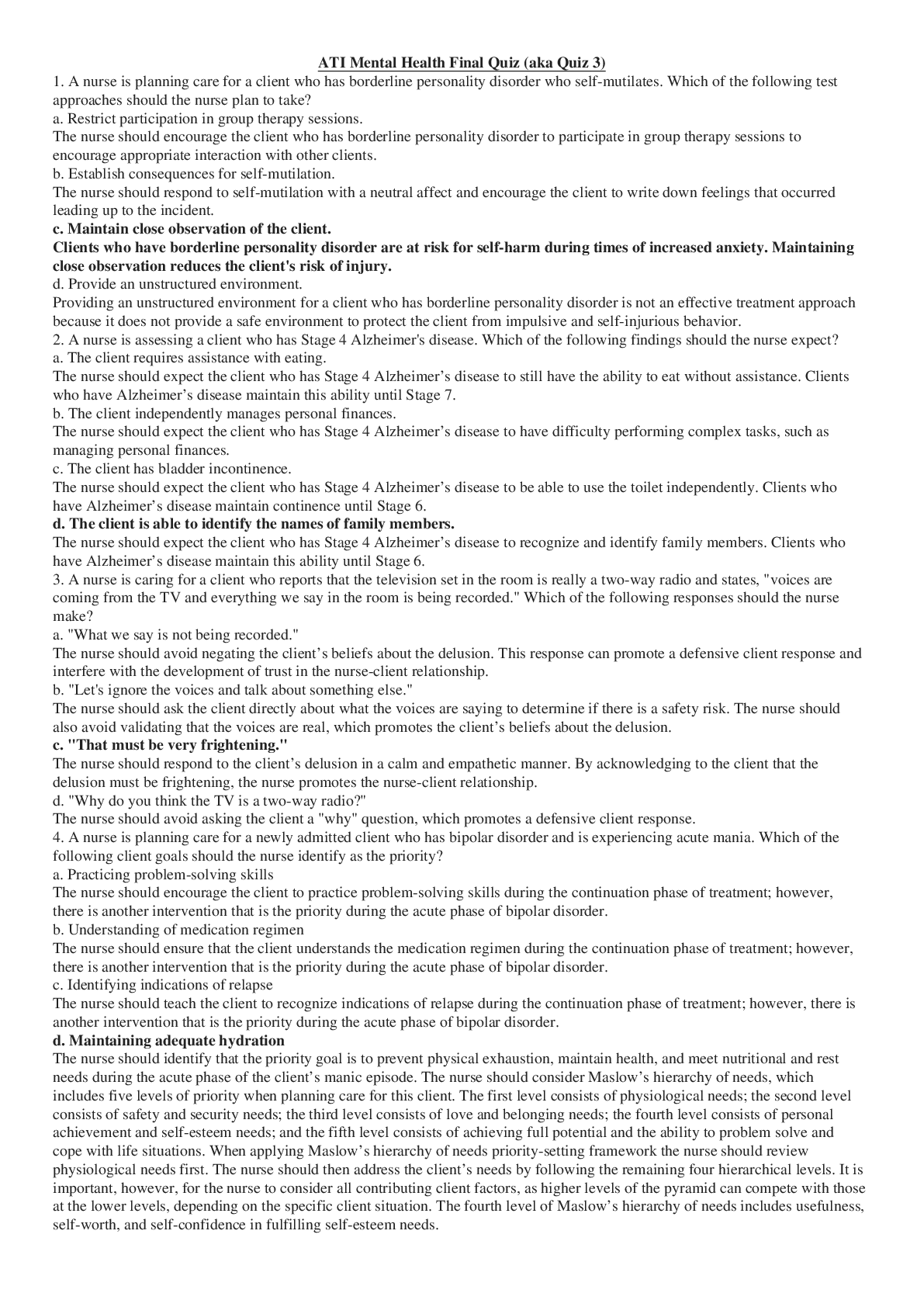

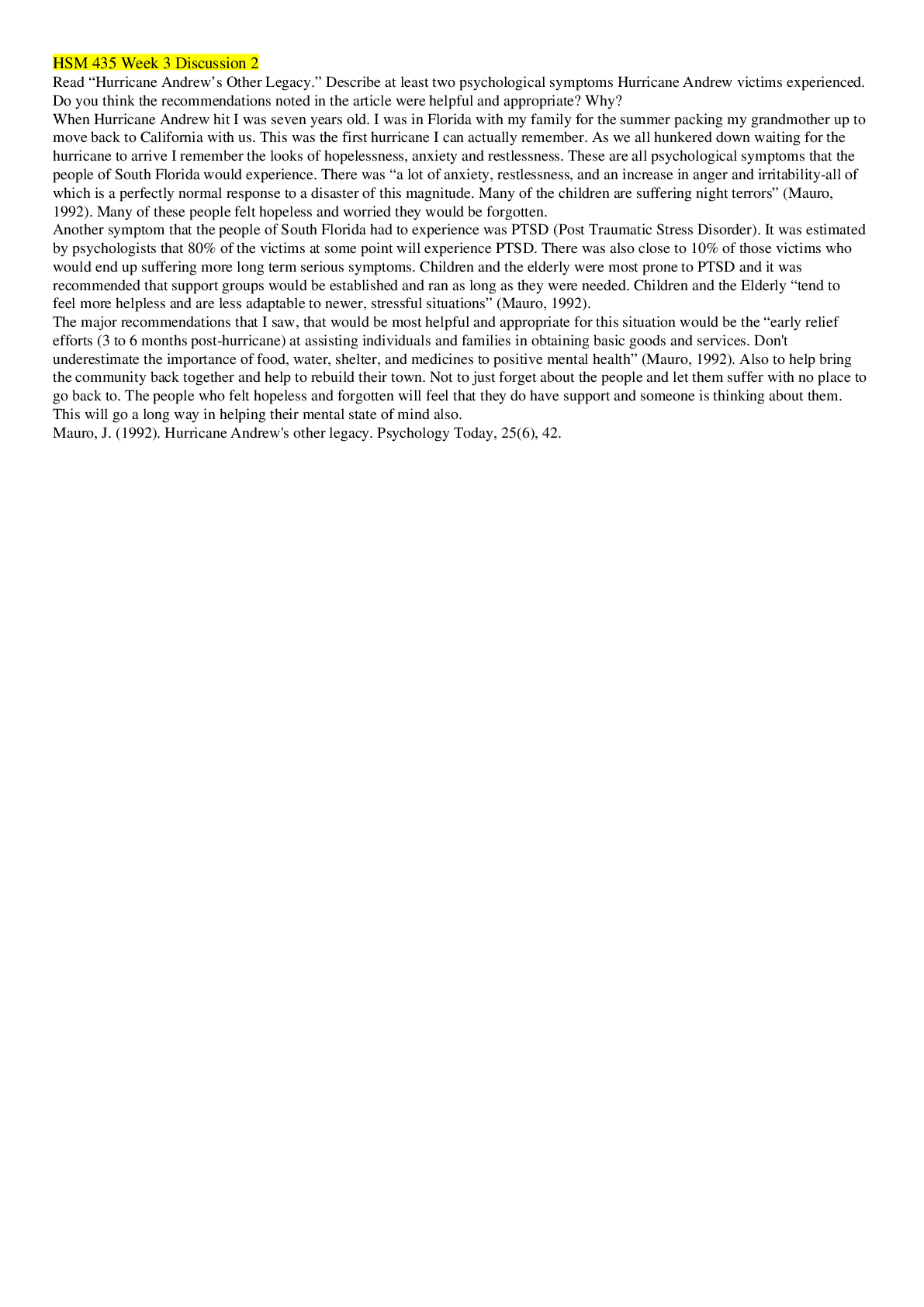
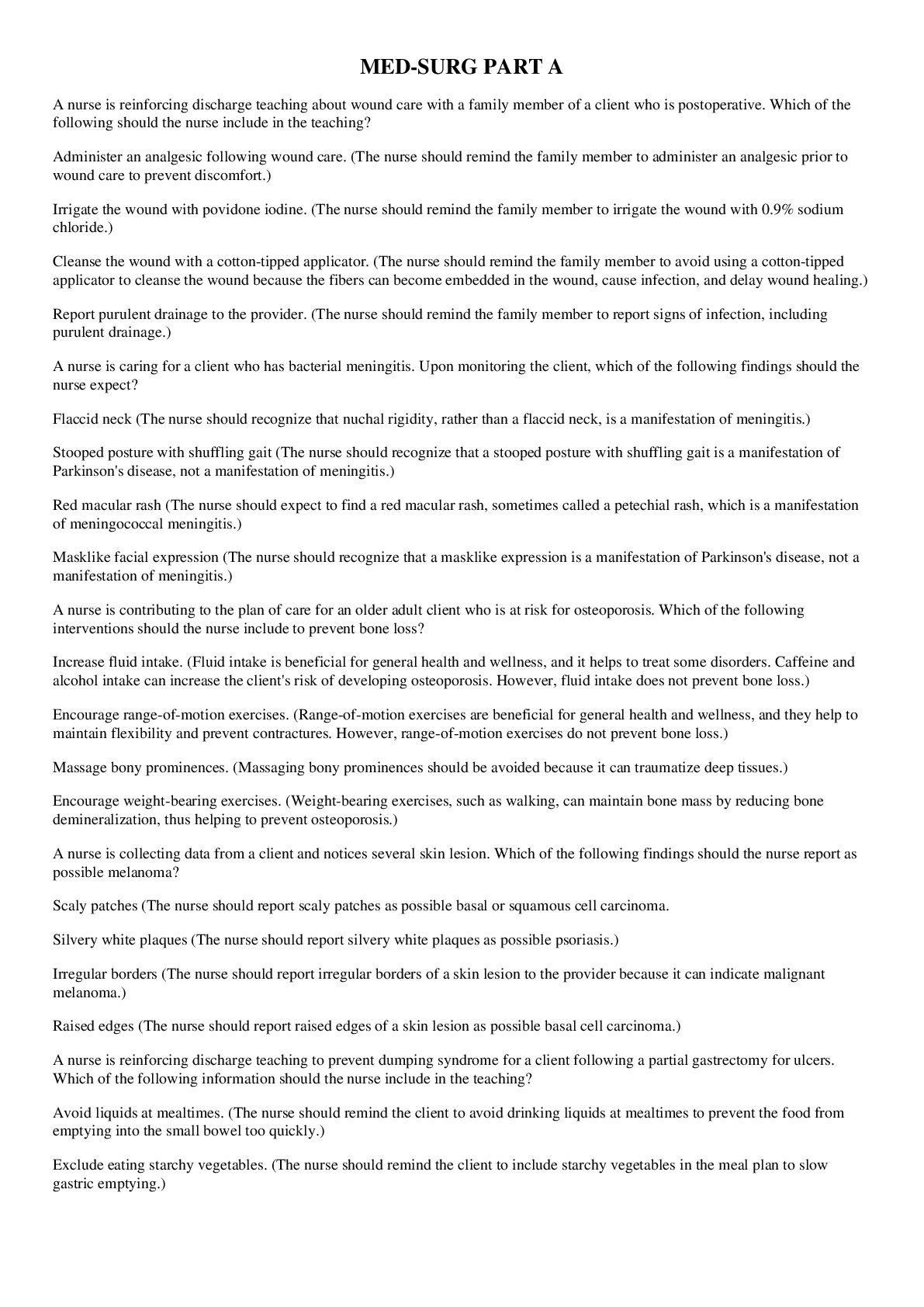


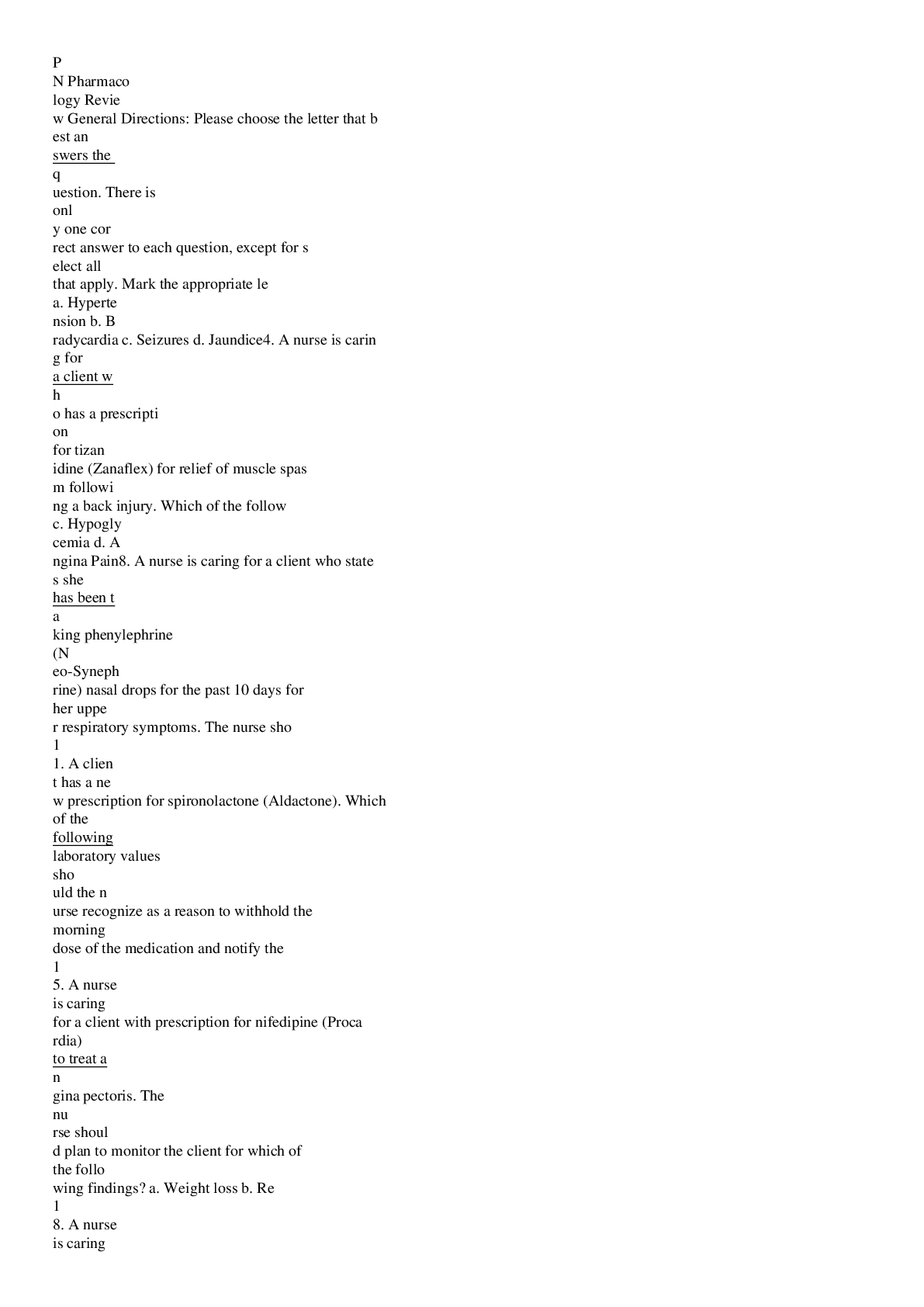
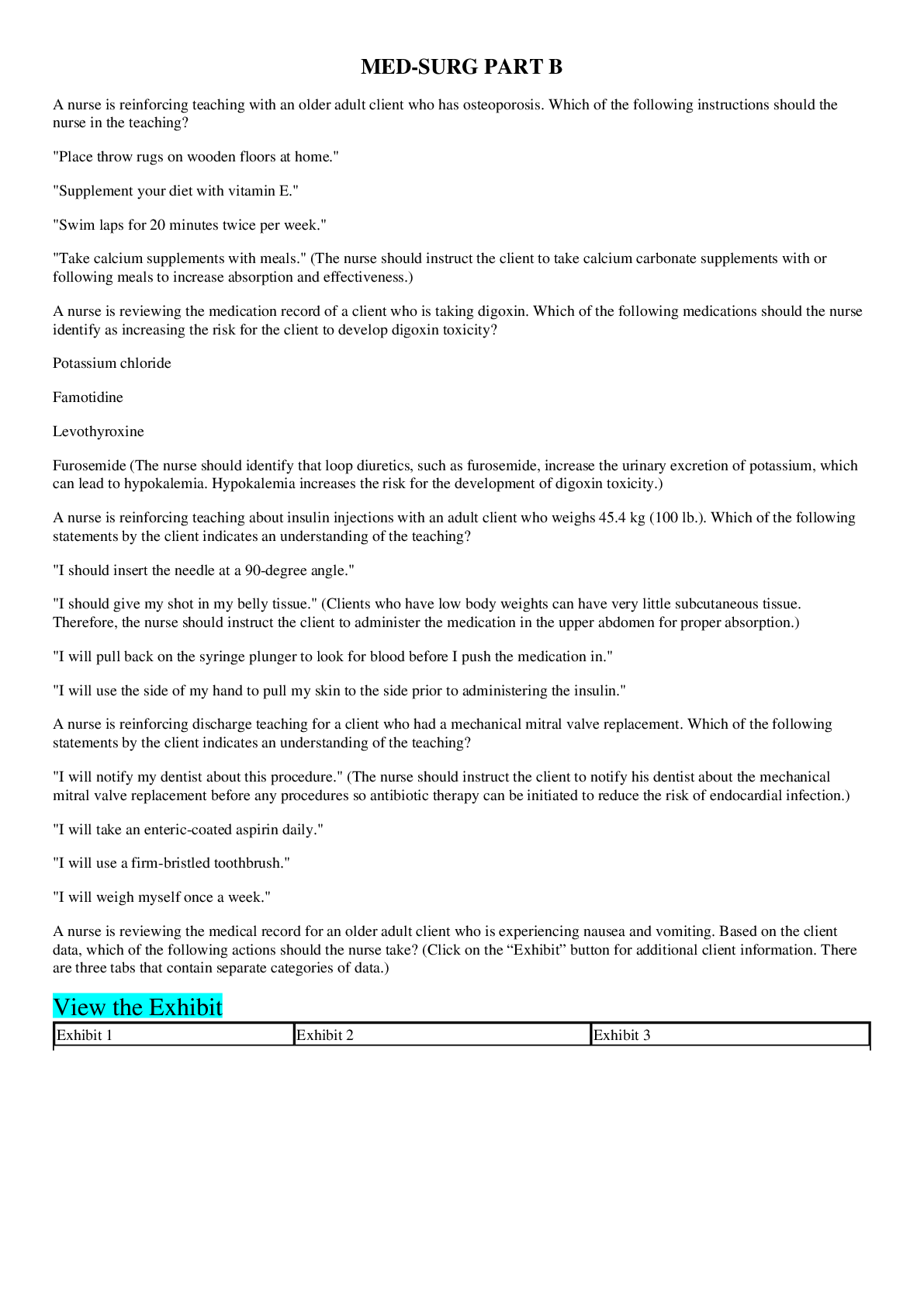
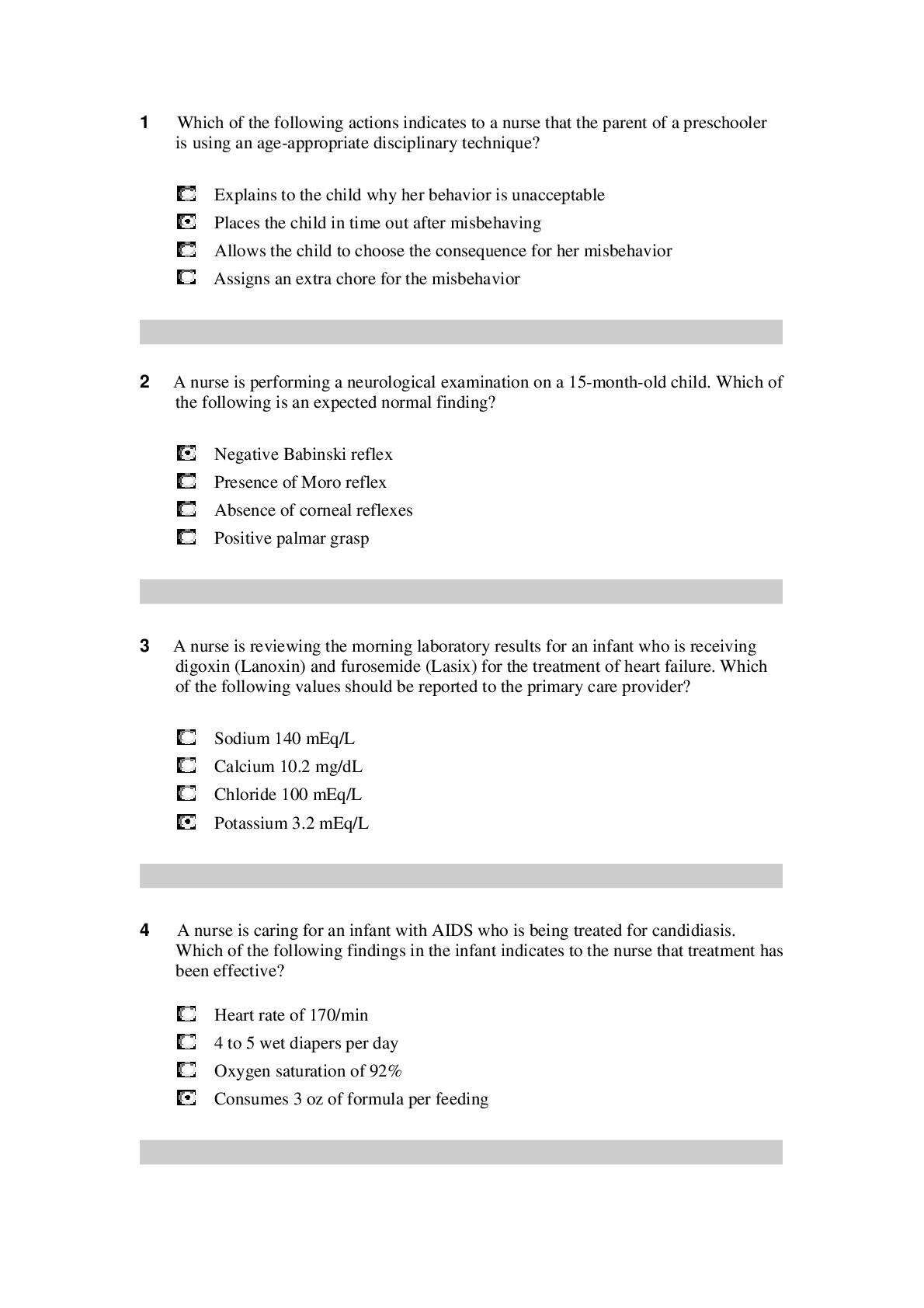

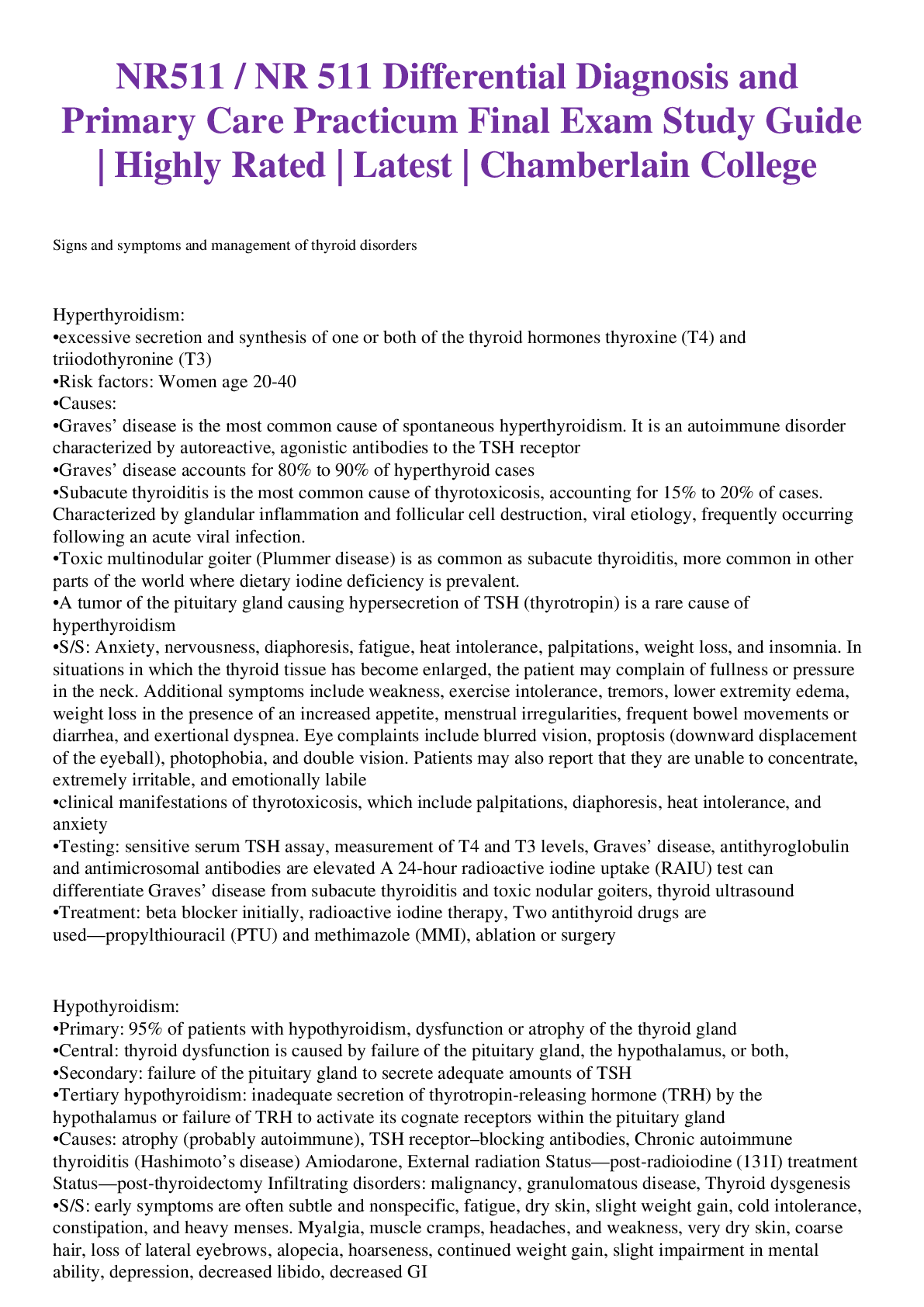

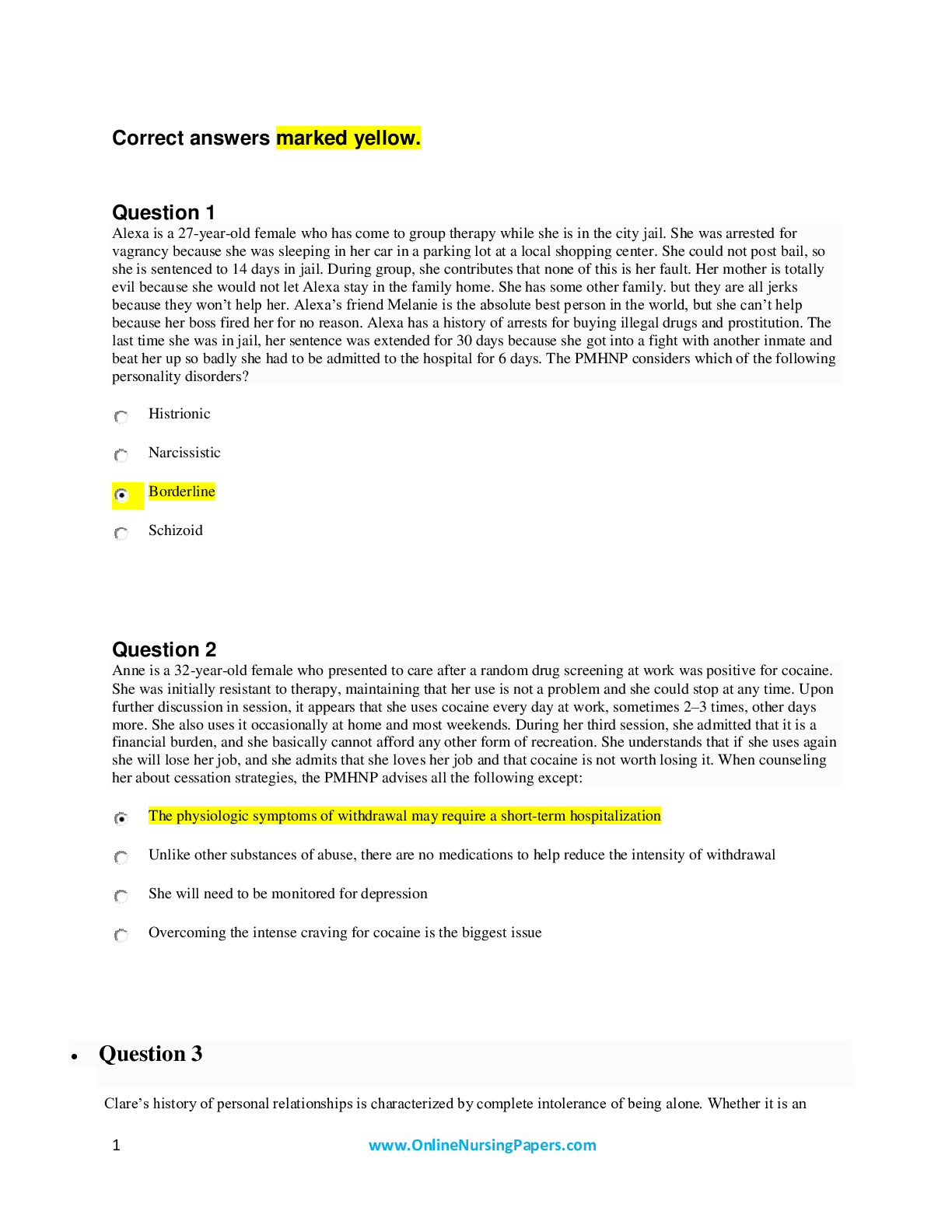
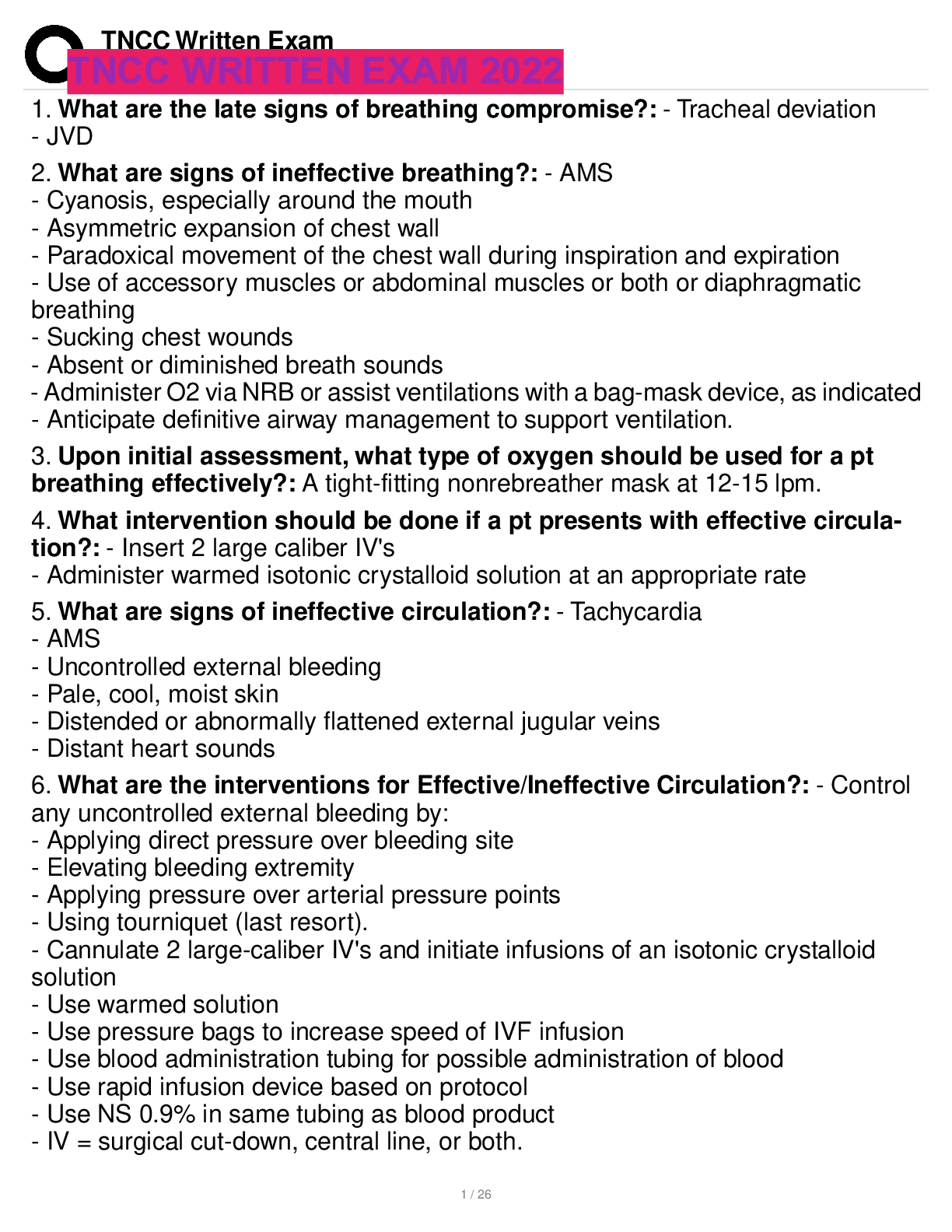
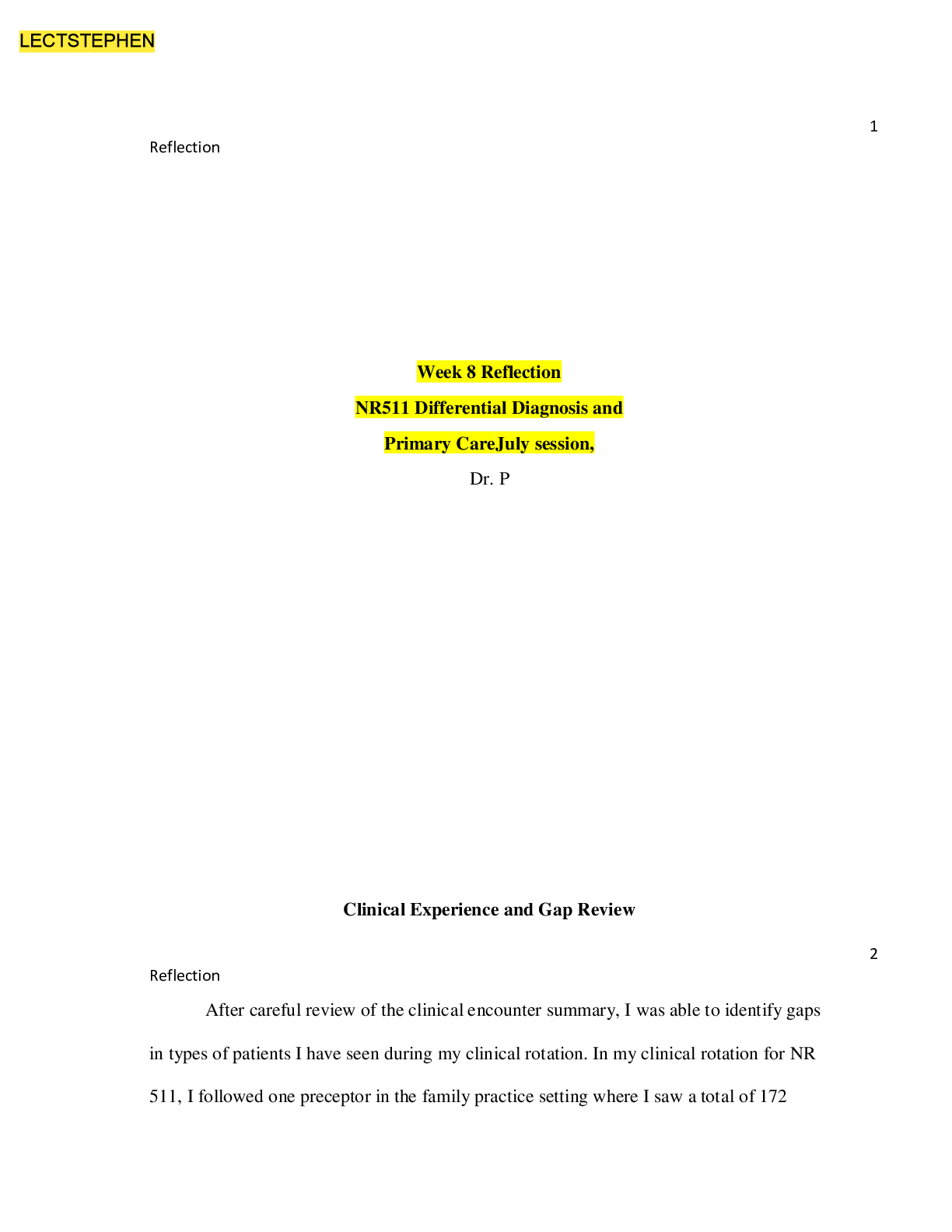
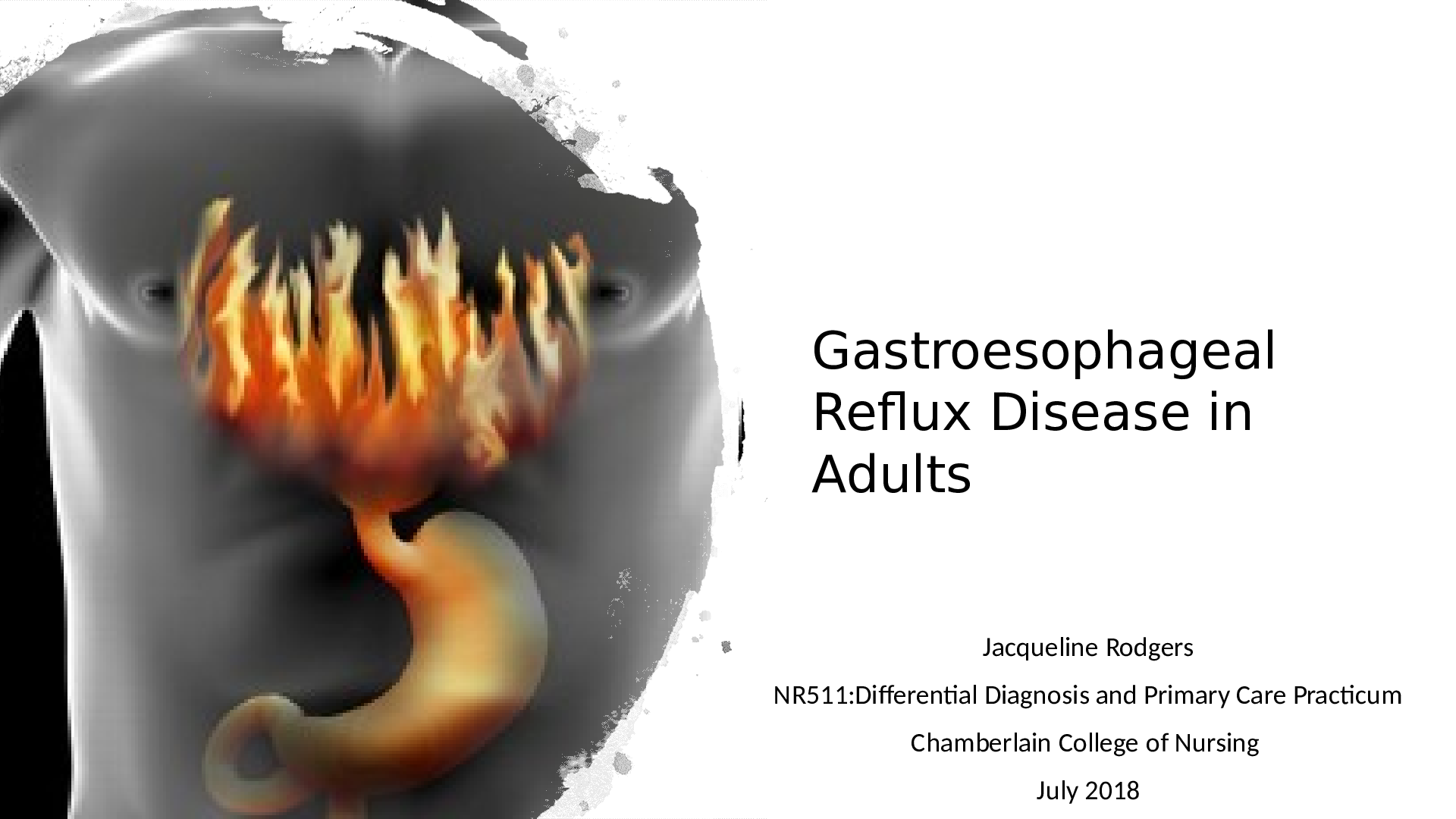
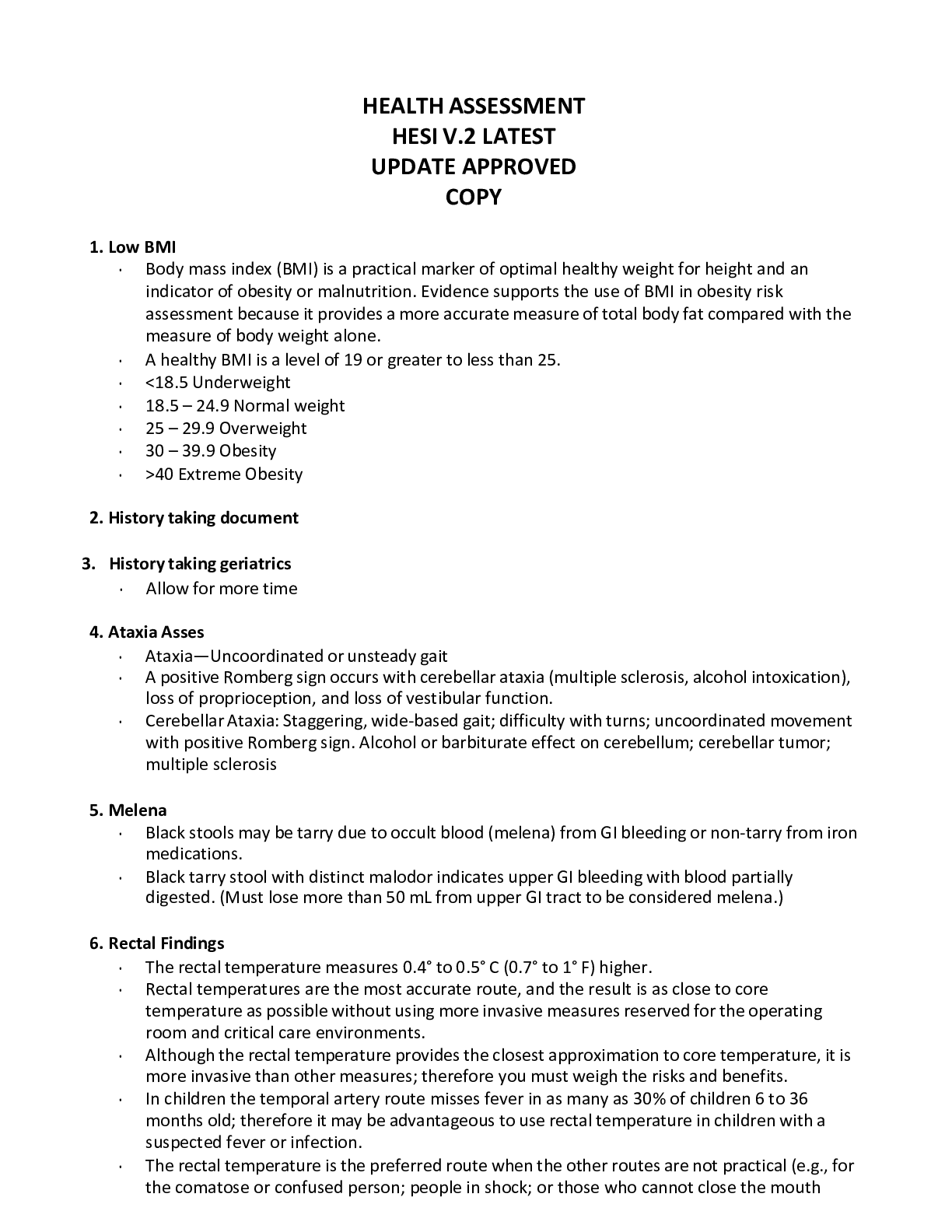

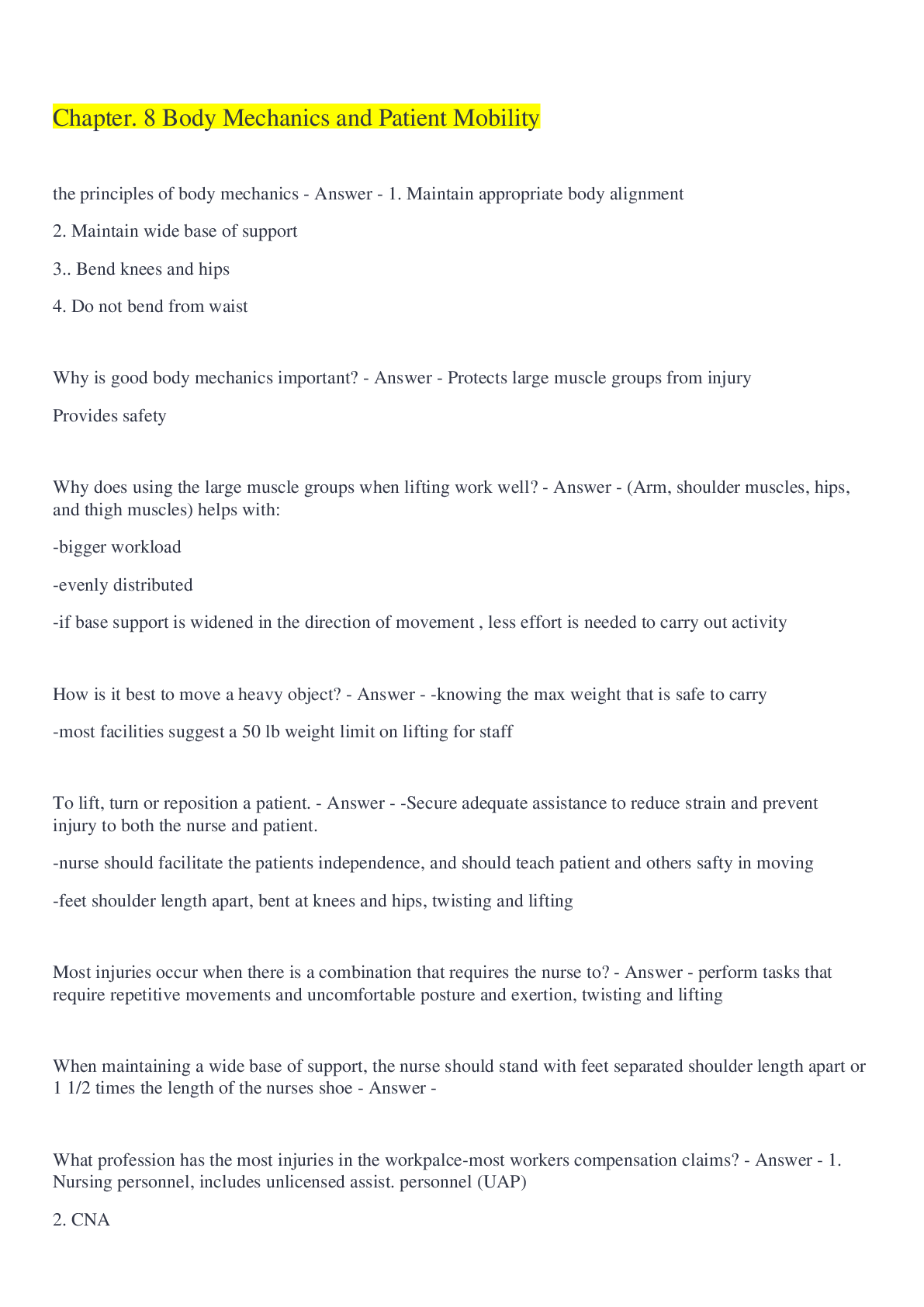
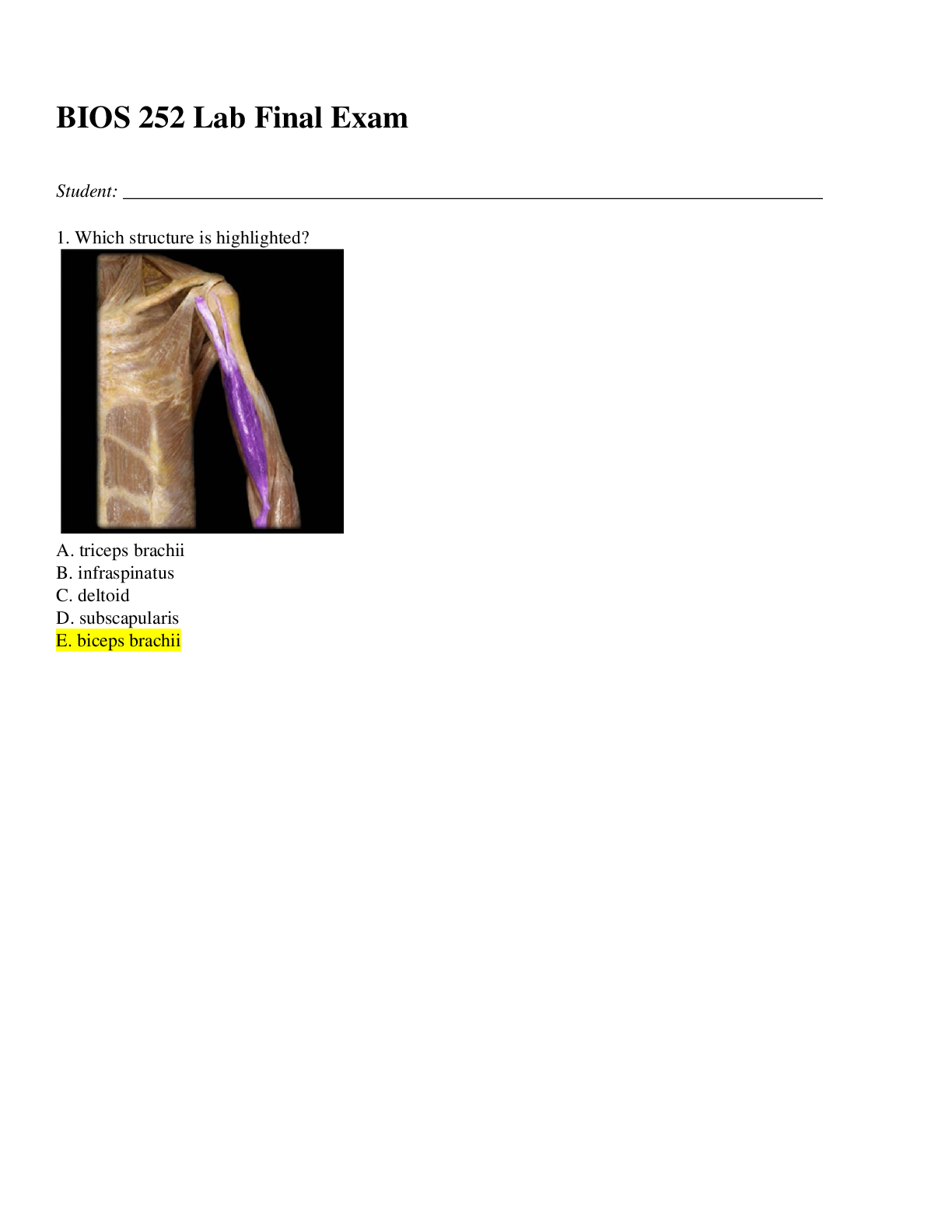
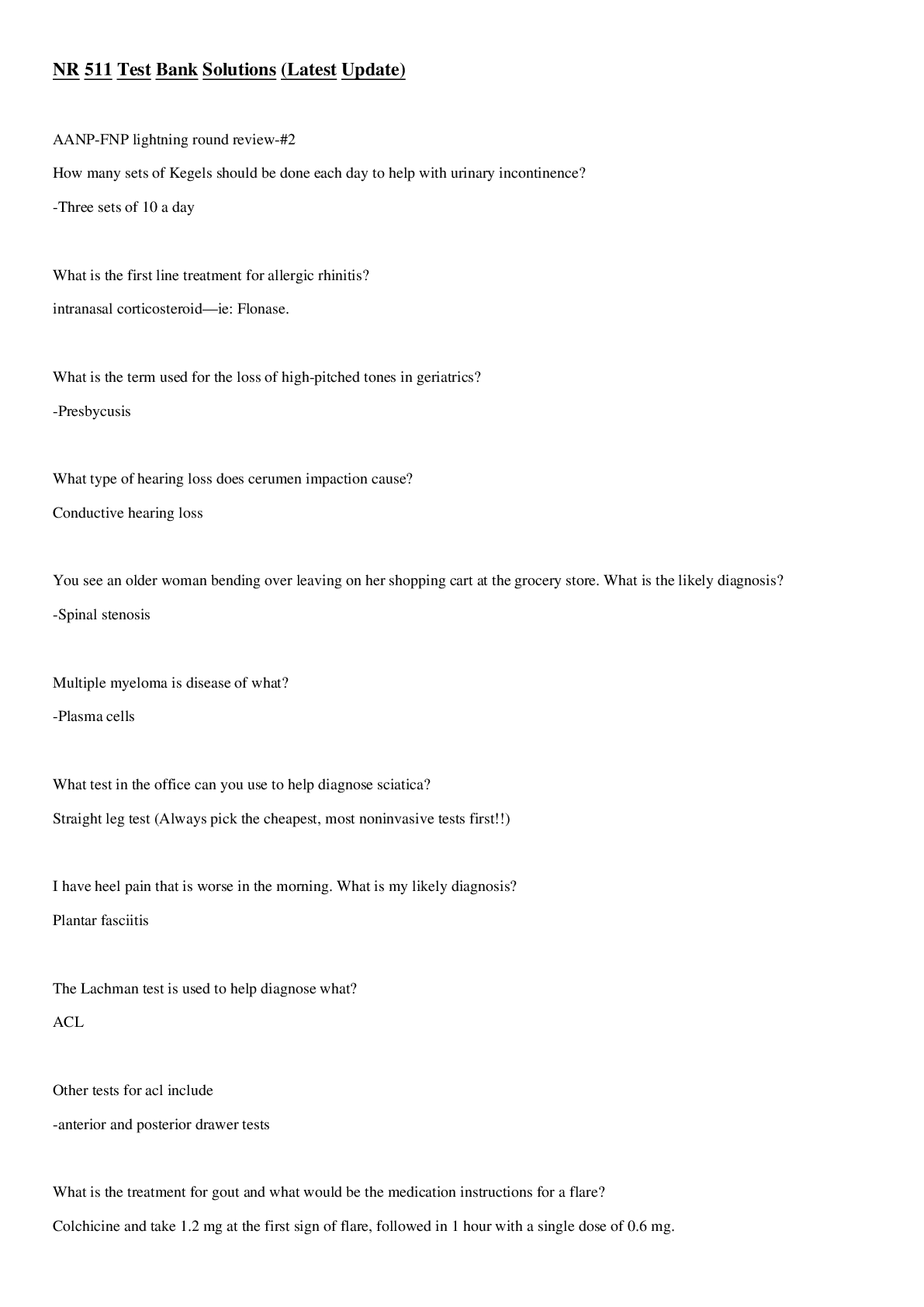
 Graded A.png)

